






AILWAY G E SERVING THE RAILWAY INDU S TR Y S INC E 1856 WWW.RAILWAYAGE.COM OCTOBER 2022 ROLLING INTO ORLANDO Brightline Realizing its Vision TIMEOUT FOR TECH Condition Trending and Predictive Analytics Drama Meter Drops from Red to Yellow DIFFICULTIES MULTI-EDGED
Every day, our high performance fasteners support safe and reliable transportation. Our GE11 e-style clip is produced with an innovative manufacturing process which signi cantly reduces internal stress, improving the fatigue performance beyond that of the legacy eClip. Approved and used by Class I and transit customers, these American-made fasteners are available in both right-handed and left-handed versions. Innovative fastener solutions are just one more way, we keep you rolling.


220057
We keep you rolling.
Railway Age, USPS 449-130, is published monthly by the Simmons-Boardman Publishing Corporation, 1809 Capitol Avenue, Omaha, NE 68102. Tel. (212) 620-7200. Vol. 223, No. 10. Subscriptions: Railway Age is sent without obligation to professionals working in the railroad industry in the United States, Canada, and Mexico. However, the pub lisher reserves the right to limit the number of copies. Subscriptions should be requested on company letterhead. Subscription pricing to others for Print and/or Digital versions: $100.00 per year/$151.00 for two years in the U.S., Canada, and Mexico; $139.00 per year/$197.00 for two years, foreign. Single Copies: $36.00 per copy in the U.S., Canada, and Mexico/$128.00 foreign All subscriptions payable in advance. COPYRIGHT© 2022 Simmons-Boardman Publishing Corporation. All rights reserved. Contents may not be reproduced without permission. For reprint information contact PARS International Corp., 102 W. 38th Street, 6th floor, New York, N.Y. 10018, Tel.: 212-221-9595; Fax: 212-221-9195. Periodicals postage paid at New York, N.Y., and additional mailing offices. Canada Post Cust.#7204564; Agreement #41094515. Bleuchip International, PO Box 25542, London, ON N6C 6B2. Address all subscriptions, change of address forms and correspondence concerning
to Subscription Dept., Railway Age, PO Box 239 Lincolnshire IL 60069-0239 USA; railwayage@omeda.com; or call +1 (402) 346-4740;

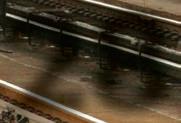
October 2022 // Railway Age 1 railwayage.com
FAX
Printed at Cummings Printing,
ISSN
(print); 2161-511X (digital). FEATURES 9 24 28 32 34 38 Financial Desk Book Multi-Edged Difficulties Tech Focus – M/W Fasteners: Hold On Tight! New York MTA The Biggest Bounces Back Tech Focus – C&S Next-Gen Train Control Rolling Into Orlando Brightline Realizes Its Dream Timeout For Tech Tenth in a Series COMMENTARY 2 8 44 From the Editor Watching Washington ASLRRA Perspective DEPARTMENTS 4 6 7 41 42 42 43 Industry Indicators Industry Outlook Market People Professional Directory Classifieds Advertising Index COVER PHOTO An Ontario Southland Railway snowplow train slices through deep drifts on the St. Thomas Subdivision, Gladstone, Ont. Stephen C. Host photo OCTOBER 2022 28 AILWAY GE
subscriptions
+1 (847) 291-4816.
Hooksett, N.H.
0033-8826
Remembering Jim Florio
hose of you who take an interest in rail road history, particu larly the business side, are well aware of the role the 1980 Staggers Rail Act played in shaping our industry as it exists today. But you may not be aware the legislation that enabled partial economic deregulation—I emphasize the adjective “partial” because the noun “deregulation” should never, ever be used without it—wasn’t crafted by the con gressman, Harley O. Staggers (D-W.Va.), for which it was named. The actual author was a young congressman, a Democrat with a working-class background who represented a rather gritty area of “South Jersey” that included Camden (just across the Delaware River from Philadelphia): James J. Florio.
Jim Florio died at 85 last month (p. 41). I knew him best as Governor of my home state, New Jersey, from 1990 to 1994. I think it’s fair to say the Staggers Rail Act was one of his greatest legislative accomplishments, if not the greatest. So why was his name not on the bill?
The simple answer is that Florio put substance before politics, and had the ability to “reach across the aisle” to get things done—something sadly lacking in today’s poisonously partisan, “us vs. them,” environ ment. He also knew that having his name on a bill was far less important than what that bill would actually accomplish.
Railway Age Capitol Hill Contributing Editor Frank N. Wilner, who arguably knows railroad regulation and legislation better than most, interviewed Florio several times for this publication. He explains: “The Staggers Rail Act is named after a longdeceased and now hazily, if at all, remembered West Virginia Democratic lawmaker—Harley O. Staggers—but
TStaggers didn’t even write the bill that carries his name, nor did he manage its successful passage. Much of the bill writing, as well as its majority-vote getting, was accomplished by Rep. James J. Florio (D-N.J.), Chairman of what was then the House Transportation Subcommittee (now the Subcommittee on Railroads, Pipelines and Hazardous Materials). In a last-ditch effort to inch over the finish line what was then the Rail Act of 1980—which was in danger of being rele gated to the dust bin of history—Florio, in a flash of political savvy, renamed it to honor Staggers, about to retire and still the immensely popular Chairman of the House Interstate and Foreign Commerce Committee (now Transportation and Infrastructure Committee). The name change to the “Harley O. Staggers Rail Act” similarly earned for the bill bipartisan support in the Senate.”
Frank Wilner questions “why railroaders speak repeatedly of the increasingly unfamil iar and four-decades-old Staggers Rail Act.” It’s because the legislation “at least provides modern-day opinion leaders and decisionmakers not steeped in railroad history an inkling that the law has to do with railroads.”
We can thank Jim Florio for that.
We can also thank long-time Railway Age Contributing Photographer Joseph M. Calisi, my friend and colleague for 30 years, for his many beautiful railroad images that have appeared in print and online these past three decades. Joe, who had recently retired from the New York MTA, died unexpectedly last month. The New York City Transit photo on pages 1 and 28 is our tribute to him.
Riposa in pace, Jim and Joe.
WILLIAM C. VANTUONO Editor-in-Chief

Railway Age, descended from the American Rail-Road Journal (1832) and the Western Railroad Gazette (1856) and published under its present name since 1876, is indexed by the Business Periodicals Index and the Engineering Index Service. Name registered in U.S. Patent Office and Trade Mark Office in Canada. Now indexed in ABI/Inform.
Change of address should reach us six weeks in advance of next issue date. Send both old and new addresses with address label to Subscription Department, Railway Age, PO Box 239, Lincolnshire IL 60069-0239 USA, or call (US, Canada and International) +1 (402) 346-4740, Fax +1 (847) 291-4816, e-mail railwayage@omeda.com. Post Office will not forward copies unless you provide extra postage.

POSTMASTER: Send changes of address to: Railway Age, PO Box 239, Lincolnshire, IL 60069-0239, USA.
Photocopy rights: Where necessary, permission is granted by the copyright owner for the libraries and others registered with the Copyright Clearance Center (CCC) to photocopy articles herein for the flat fee of $2.00 per copy of each article. Payment should be sent directly to CCC. Copying for other than personal or internal reference use without the express permission of Simmons-Boardman Publishing Corp. is prohibited. Address requests for permission on bulk orders to the Circulation Director. Railway Age welcomes the submission of unsolicited manuscripts and photographs. However, the publishers will not be responsible for safe keeping or return of such material.
Member of:
SUBSCRIPTIONS: 1 (402) 346-4740
EDITORIAL AND EXECUTIVE OFFICES
Simmons-Boardman Publishing Corp. 1809 Capitol Avenue Omaha, NE 68102 (212) 620-7200 www.railwayage.com
ARTHUR J. McGINNIS, Jr. President and Chairman
JONATHAN CHALON Publisher jchalon@sbpub.com
WILLIAM C. VANTUONO
Editor-in-Chief wvantuono@sbpub.com
MARYBETH LUCZAK
Executive Editor mluczak@sbpub.com
CAROLINA WORRELL Senior Editor cworrell@sbpub.com
BILL WILSON
Engineering Editor/Railway Track & Structures Editor-in-Chief wwilson@sbpub.com
DAVID C. LESTER
Managing Editor, Railway Track & Structures dlester@sbpub.com
HEATHER ERVIN
Ports and Intermodal Editor/Marine Log Editor-in-Chief hervin@sbpub.com
Contributing Editors
David Peter Alan, Jim Blaze, Nick Blenkey, Sonia Bot, Peter Diekmeyer, Alfred E. Fazio, Don Itzkoff, Bruce Kelly, Ron Lindsey, David Nahass, Jason H. Seidl, David Thomas, John Thompson, Frank N. Wilner, Tony Zenga Art Director: Nicole D’Antona
Graphic Designer: Hillary Coleman Corporate Production Director: Mary Conyers Production Director: Eduardo Castaner Marketing Director: Erica Hayes Conference Director: Michelle Zolkos Circulation Director: Joann Binz
INTERNATIONAL OFFICES
46 Killigrew Street, Falmouth, Cornwall TR11 3PP, United Kingdom 011-44-1326-313945
International Editors Kevin Smith ks@railjournal.co.uk
David Burroughs dburroughs@railjournal.co.uk David Briginshaw db@railjournal.co.uk Robert Preston rp@railjournal.co.uk Simon Artymiuk sa@railjournal.com
CUSTOMER SERVICE: RAILWAYAGE@OMEDA.COM , OR CALL 1 (402) 346-4740 Reprints: PARS International Corp. 253 West 35th Street 7th Floor New York, NY 10001 212-221-9595; fax 212-221-9195 curt.ciesinski@parsintl.com
2 Railway Age // October 2022 railwayage.com FROM THE EDITOR
AILWAY GE
WHEN YOUR BUSINESS RELIES ON RAIL, RELY ON US.














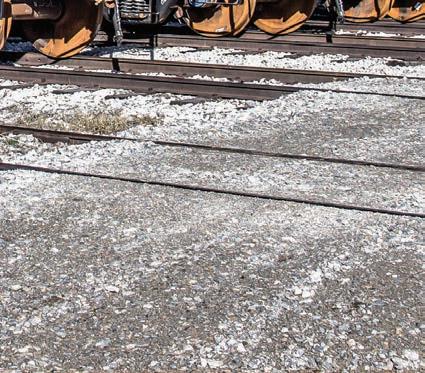
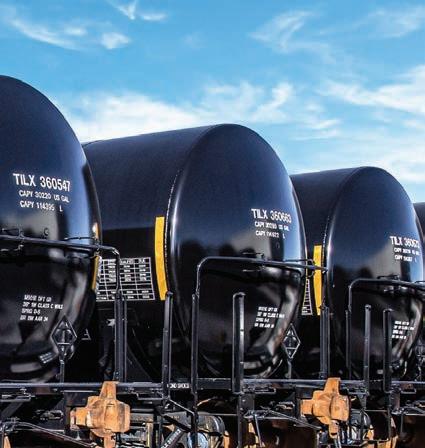

is North America’s leading railcar equipment and services provider. With a comprehensive platform of leasing, manufacturing, maintenance and professional services, you can rely on TrinityRail to fully deliver trusted expertise, innovative solutions and supply chain optimization. Learn more at TrinityRail.com.
TrinityRail®
‘GET USED TO DISAPPOINTMENT’
“If you were expecting August rail traffic to provide a definitive statement regarding the state of the economy, well, get used to disappointment,” the Associa tion of American Railroads reported last month. “As in June and July, rail traffic in August was relatively evenly balanced between categories with carload gains and those with declines. In August, 11 of the 20 carload categories we track had gains. Total carloads were up 2.3% over last year; weekly average total carloads (237,978) were the most since May 2021. Coal and grain led the way, but for neither of those are carloads closely correlated with the state of the economy. Industrial products, carloads of which are closely correlated to the broader economy, saw carloads rise 0.1% in August after small declines the previous three months. Excluding coal, U.S. rail carloads were up 1.2% in August, their first increase in six months. Meanwhile, August was the 12th decline in the past 13 months for intermodal, but August’s 1.2% decline was the smallest percentage decline in those 13 months.”
31,61528,68910.2% Chemicals 163,400162,7520.4% Petroleum & Petroleum Products48,34051,750-6.6% Coal 350,686333,2185.2%
Primary Forest Products 5,8065,23910.8%
Lumber & Wood Products 16,31215,816 3.1%
Pulp & Paper Products 26,89528,944 -7.1%
Metallic Ores 32,16430,6415.0%
Coke 18,064 18,436 -2.0%
Primary Metal Products 40,84947,560-14.1%
Iron & Steel Scrap 20,26821,367-5.1%
Motor Vehicles & Parts 69,157 66,439 4.1%

Crushed Stone, Sand & Gravel 110,171102,844 7.1%
Nonmetallic Minerals 19,37019,448-0.4% Stone, Clay & Glass Products 39,83042,715-6.8% Waste & Nonferrous Scrap 19,03019,806-3.9%
All Other Carloads 26,05630,970-15.9%
4 Railway Age // October 2022 railwayage.com
Indicators
Industry
Source: Rail Time Indicators, Association of American Railroads Intermodal MAJOR U.S. RAILROADS BY COMMODITY AUG. ’22AUG. ’21% CHANGE Trailers 74,896101,917-26.5% Containers 1,260,722 1,249,557 0.9% TOTAL UNITS 1,335,6181,351,474 -1.2% CANADIAN RAILROADS Trailers 0 0 Containers 374,533360,1844.0% TOTAL UNITS 374,533360,1844.0% COMBINED U.S./CANADA RR Trailers 74,896101,917-26.5% Containers 1,635,255 1,609,741 1.6% TOTAL COMBINED UNITS 1,710,151 1,711,658 -0.1% FIVE WEEKS ENDING SEPTEMBER 3, 2022 Railroad employment, Class I linehaul carriers, AUGUST 2022 (% change from AUGUST 2021) Transportation (train and engine) 48,760 (+3.50%) Executives, Officials and Staff Assistants 7,900 (+8.65%) Professional and Administrative 9,791 (-0.63%) Maintenance-of-Way and Structures 28,437 (+0.36%) Maintenance of Equipment and Stores 17,410 (+1.19%) Transportation (other than train & engine) 4,716 (+1.22%) Source: Surface Transportation Board TOTAL EMPLOYEES: 117,014 % CHANGE FROM AUGUST 2021: +2.26%
ORIGINATED CARLOADS
BY COMMODITY AUG. ’22AUG. ’21% CHANGE Grain
Farm Products excl. Grain
Grain Mill Products
Food Products
TRAFFIC
MAJOR U.S. RAILROADS
102,09889,50414.1%
3,707 2,86929.2%
46,07443,8455.1%
CARLOADS 377,251
U.S./CANADA RR 1,567,143
FIVE WEEKS ENDING SEPTEMBER 3, 2022
TOTAL U.S. CARLOADS 1,189,892 1,162,852 2.3% CANADIAN RAILROADS TOTAL CANADIAN
368,9282.3% COMBINED
1,531,780 2.3%
30,351 24,38224.5%

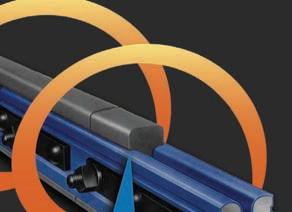




81,529 76,383 6.7%

October 2022 // Railway Age 5 railwayage.com TOTAL U.S. Carloads and intermodal units, 2013-2022 (in millions, year-to-date through august 2022, SIX-WEEK MOVING AVERAGE) TOTAL U.S./Canadian CARLOADS, august 2022 VS. august 2021 1,567,1431,531,780 AUGUST 2022 AUGUST 2021 Copyright © 2022 All rights reserved. Short Line And Regional Traffic Index CARLOADS BY COMMODITY ORIGINATED AUGUST ’22 ORIGINATED AUGUST ’21 % CHANGE Chemicals
Stone, Sand & Gravel
Food & Kindred Products
Carloads
The Insulated Joint Designed To Handle Stress
GET A QUOTE (833) 224-9628 Meets all current AREMA specifications Easy installation, minimum maintenance Rail sizes from 30 - 141 pounds Specialty formulated polyurethane bonded
53,736 52,995 1.4% Coal 19,236 24,654-22.0% Crushed
12,228 10,56415.8% Grain 26,669 21,87921.9% Grain Mill Products 8,526 7,66811.2% Lumber & Wood Products 10,559 9,46111.6% Metallic Ores 2,749 3,338 -17.6% Metals & Products 20,019 18,910 5.9% Motor Vehicles & Equipment 9,390 9,677 -3.0% Nonmetallic Minerals 2,629 2,475 6.2% Petroleum Products 2,169 2,109 2.8% Pulp, Paper & Allied Products 18,753 17,721 5.8% Stone, Clay & Glass Products 16,735 16,364 2.3% Trailers / Containers 46,486 54,475-14.7% Waste & Scrap Materials 12,204 12,088 1.0% All Other
Because of their bonded-tosteel construction, Seneca joints flex as a unit with vertical & horizontal stress. Making them virtually immune to coldflow under the most rugged use & environmental conditions.
Industry Outlook
unions—even those who have ratified tentative agreements—to honor picket lines. While rail labor contracts prohibit so-called “sympathy strikes,” a loophole allows unionized workers to honor picket lines of other unions if members personally feel threatened were they to cross them.
Might Union Chiefs Override Member Vote?
If tentative wages, benefits and work rules agreements reached between rail labor unions and most Class I rail roads (and many smaller ones) fail to be ratified by union members in coming weeks, might leadership of those unions override a majority “no” vote and unilater ally impose the tentative agreement, or, alternatively, submit it to binding arbitra tion rather than pursue further collective bargaining or authorize a strike? It’s currently an unanswered question. And it has happened before.
For example, in 1996, the leadership of the United Transportation Union—now the Transportation Division of the Sheet Metal, Air, Rail and Transportation Workers (SMART-TD)—overrode its members’ rejection of a tentative agreement on wages, benefits and work rules. Rather than return to the negotiating table or order a work stoppage, either of which was sought by members, the union’s leadership made a deal with carriers to send the memberrejected tentative contract to binding arbitration, where a carrier-friendly award was imposed.

What actually lurks in various rail labor union constitutions—especially those provisions’ interpretation by union offi cers—is unknown. The answer will become apparent over the next few weeks.
Fringe factions of rail labor have been
predicting—even urging—“no” votes. Mainstream media, in reporting on those efforts and discontent among rail union members, has provided nattering nabobs of negativism credibility and a pulpit from which to preach against ratification. As the RLA (Railway Labor Act) has run its course, there now is no law keeping even a single rail labor union from striking, or carriers from locking out workers if union members decline to ratify tentative agreements.
Last month, following a 20-hour negoti ating session on the eve of RLA work-stoppage barriers expiring, several Biden Administration cabinet officers brought about tentative agreements with several hold-out unions. Last-minute nego tiated sweeteners conceded by the carriers made the difference.
But the tentative agreements only post pone the threat of a work stoppage, as union member rejection could trigger one. Even a strike against one railroad could cause a nationwide rail shutdown, as occurred in 1992 against CSX. All other major railroads responded by locking out employees, contending the nation’s rail network is so interconnected and interde pendent that a strike against one railroad is a strike against all.
Moreover, a strike by even a small union could trigger a full-blown nationwide rail shutdown by causing members of all other
Notwithstanding the Biden Administration basking in the political sunlight of tentative agreements being reached, the threat of an economy-jolting nationwide rail shutdown remains—and will be pinned on Biden and Democrats if it occurs prior to mid-term elections in November. Hence, there’s chatter as to whether rail labor leaders, very much invested in Democratic success in mid-term elections, might override a membership rejection of the tentative agreement or, alternatively, seek binding arbitration so as to avoid a work stoppage damaging to Democratic candidates.
Efforts by Congress to craft immediate and economy-saving back-to-work legisla tion in the event of a strike or lockout were unsuccessful. If union members reject ratification, and Congress remains unable to craft back-to-work legislation, the length of a national rail shutdown would be indeterminate.
The sides could agree not to engage in a strike or lockout until after November midterm congressional elections, although Congress would remain as politically divided as it is today—and will remain so at least until a new Congress is seated in January. Moreover, during lame-duck sessions following mid-term elections and before a new Congress is seated, defeated and retiring lawmakers become less concerned with public image or political debts, and mavericks become more embold ened. This festering impending chaos all could have been avoided had the National Mediation Board followed decades of prec edent and held the parties in mediation until after the elections, but it didn’t.
One union officer, asking not to be identified, said, “The RLA is silent as to the ratification process, which is found in each union’s constitution. Some arbitra tors have ruled that the membership lacks the authority to second-guess the agreedupon best efforts of the carriers and union leadership.”
– Frank N. Wilner
6 Railway Age // October 2022 railwayage.com
SMART-TD
SMART-TD President Jeremy Ferguson
California Ramps Up HFC
Stadler, the California State Transportation Agency (CalSTA) and the California Department of Transportation (Caltrans) have signed a Memorandum of Understanding (MOU) for design and delivery of four HFC (hydrogen fuel cell) fourcar FLIRT H2 trainsets. The contract includes options for 25 more units, which would replace existing diesel locomotive-operated push-pull sets used for state-funded Amtrak California services. These trainsets are based upon the initial two-car HFC trainset ordered by San Bernardino County Transportation Authority (SBCTA) from Stadler in 2019, due to enter service in 2024 on the new ninemile SBCTA San Bernardino Transit CenterUniversity of Redlands line alongside newly delivered Arrow low-emission Stadler FLIRT DMUs. Ballard Power Systems will supply six 100 kW FCmove™HD+ fuel cell engines to power the SBCTA train.

WORLDWIDE
WABTEC and KAZAKHSTAN TEMIR ZHOLY have signed a $600 million MOU for 150 FLXdrive™ battery-electric switchers and modernization work to transform the KTZ main line diesel-electric fleet into Next Fuel™ LNG-powered locomotives. The switchers will be 100% battery powered with more than 1.5 MwH of energy. They are claimed to have the ability to reduce the rail road’s yard operations fuel cost by approxi mately $75,000 per unit per year and reduce scheduled maintenance by up to 97%.
NORTH AMERICA
TELEGRAPH, a Chicago-based startup offering a cloud-based operating system for railroads, shippers, logistics service providers and railcar leasing companies, has partnered with WATCO to help shippers with tough logistics challenges, with a focus on rail trans portation. “Telegraph helps railroads, ship pers, logistics providers and railcar lessors work more efficiently via a singular platform,” the company said. Its platform “up-levels the consumer experience, making it easier for businesses to incorporate rail into their pro curement and execution processes. The com bination of Watco’s decades of rail logistics experience and Telegraph software provides customers visibility of their railcars beyond Watco facilities or tracks. Telegraph provides exceptional predictability and visibility for carload and intermodal shipments. Leverag ing EDI, API and telematics integrations, the platform delivers best-in-class forecasting capability and pipeline management. To date, we have saved customers thousands of hours in manual work and millions of dollars in accessorial charges.” Said Telegraph Cofounder Shachar Astor: “We recognized a distinct need for software designed for the rail-centric supply chain.”
A LSTOM last month signed a contract renewal to carry out preventive and cor rective maintenance on 186 locomotives of the FERROCARRIL M ÉXI C ANO (FERROMEX) fleet for a period of five years. Alstom’s commercial relationship with Ferromex began in 2004 and has allowed for “a synergy in favor of rail mobility in Mexico,” the company said. According to Alstom, this service contract, implementing remote monitoring, “con sists of performing preventive and correc tive maintenance on the locomotives, applying condition-based maintenance technologies, and performing predictive maintenance through vibration analysis and oil chemical analysis.” Maintenance work will be carried out at the Ferromex centers located in Torreón, Chihuahua and Guadalajara. “The renewed confidence in Alstom with this additional maintenance contract reaffirms Alstom’s commitment to assisting Ferromex in the optimization of its operations with increased fleet reli ability and availability for a more efficient and sustainable transportation network,” said Maite Ramos Gómez, General Direc tor at Alstom Mexico.
October 2022 // Railway Age 7 railwayage.com Market
Stadler
Can STB Avoid Political Division?
Surface Transportation Board (STB) Chairperson Martin J. Oberman remains as difficult to categorize today as when he arrived in January 2019. In many respects, he brings to mind mythical Roman god Janus, who, in seeing forward and backward, symbolizes change and transition.
Clearly one-of-a-kind, even at age 76, Oberman’s favored ride to work is a bicycle. Likely to roll his eyes when addressed as “Mr. Chairman,” he displays little tolerance for fools and time wasters, a trait retained from his stint as an elected Chicago alderman. Colleagues describe Oberman, who controls the agency’s docket, as consensus driven with inordinate patience to hear contrarian theories, and willing to allow cases to move even when the majority is not on his side.
Not a large man, Oberman’s favored bow ties for office attire cast him as a contempla tive law professor rather than a big-stick, menacing rail regulator, even though his sound bites are more the stuff of the latter:
• “There’s just not real effective competi tion among rail carriers.”
• “Except for intermodal and a handful of other areas, generally speaking, I think shippers have very little bargaining power these days.”
• “If [carriers] need another 400 crews to move trains … pay whatever price you need to get them. I don’t oversee [collective] bargaining, but I do oversee service.”
Railroads haven’t heard such bully pulpit lectures since A. Daniel O’Neal, who chaired STB predecessor Interstate Commerce Commission, walked the plank in 1979 at the urging of economic deregulation advocate President Jimmy Carter, who recruited rail regulators more likely to have on their night stands books by Ayn Rand, Milton Friedman and William F. Buckley than John Maynard Keynes, Ralph Nader and John Kenneth Galbraith.
Oberman is influenced by provisions of National Transportation Policy that include fostering “sound economic conditions,” promoting a rail system “to meet the needs of the public,” allowing to the “maximum extent possible” competition and demand to establish “reasonable” rates, and encour aging “fair wages and safe and suitable
working conditions.” His view is that “if we let railroad share price drive all decisions, we won’t have an economy that can rely on freight rail.”
Clashing with that perspective are rail road shareholders and boards of direc tors expecting CEOs to “right size” plant and work force in advance of approaching economic recessions, a looming cratering of high-margin coal traffic, and the impact on truck-competitive pricing and market share of a collectively bargained 24% unionized employee wage increase.
Oberman’s aggressive use of the bully pulpit is not incompatible with his efforts to encourage better industry behavior voluntarily, thereby facilitating unanimous votes among members with starkly differ ing views and politics. An example was his gaining Board consensus on approving CSX’s acquisition of Pan Am Railways. His use of probing questions and preliminary determinations elicited voluntary agree ments between CSX and concerned parties, avoiding third-party regulatory edicts rarely satisfying to any stakeholder.
Oberman also formed consensus to expand publicly accessible railroadreported service-metrics—again in expec tation that public shaming, including from investors, would lead to voluntary rather than regulatory fixes.
While there are deep political divisions in Congress, there are no Democratic or Republican “gang” colors flashed at the STB. “We have neither idealism nor polar ization,” Oberman says.
“True to his word [when President Biden named him chairperson], Marty has worked indefatigably to achieve consensus on the vast majority of our decisions, spending count less nights listening to members’ concerns and identifying solutions,” says STB Repub lican member Patrick J. Fuchs.
As the Board finalizes pending matters and initiates others—promising indelible impacts on shippers and railroads—colle giality will be tested. Pending decisions may expand access to rate relief for smallervalued cases; develop new rate-reasonable ness methodology; establish minimum standards under the statutory common carrier obligation; require a railroad open its privately owned track to permit two-railroad competition (reciprocal switching); and define revenue adequacy’s relationship to maximum reasonable rates.
Oberman’s fellow Board Democrat Robert Primus, says, “[We all] want rail roads to figure out ways to solve their own problems.” As they do, and with increas ing congressional interest, the question is whether the STB can continue to work collegially and ignore Washington’s politi cal divide and dysfunction.
FRANK N. WILNER Contributing Editor


8 Railway Age // October 2022 railwayage.com Watching Washington
with increasing congressional interest, the question is whether the STB can continue to work collegially and ignore Washington’s political divide and dysfunction.”
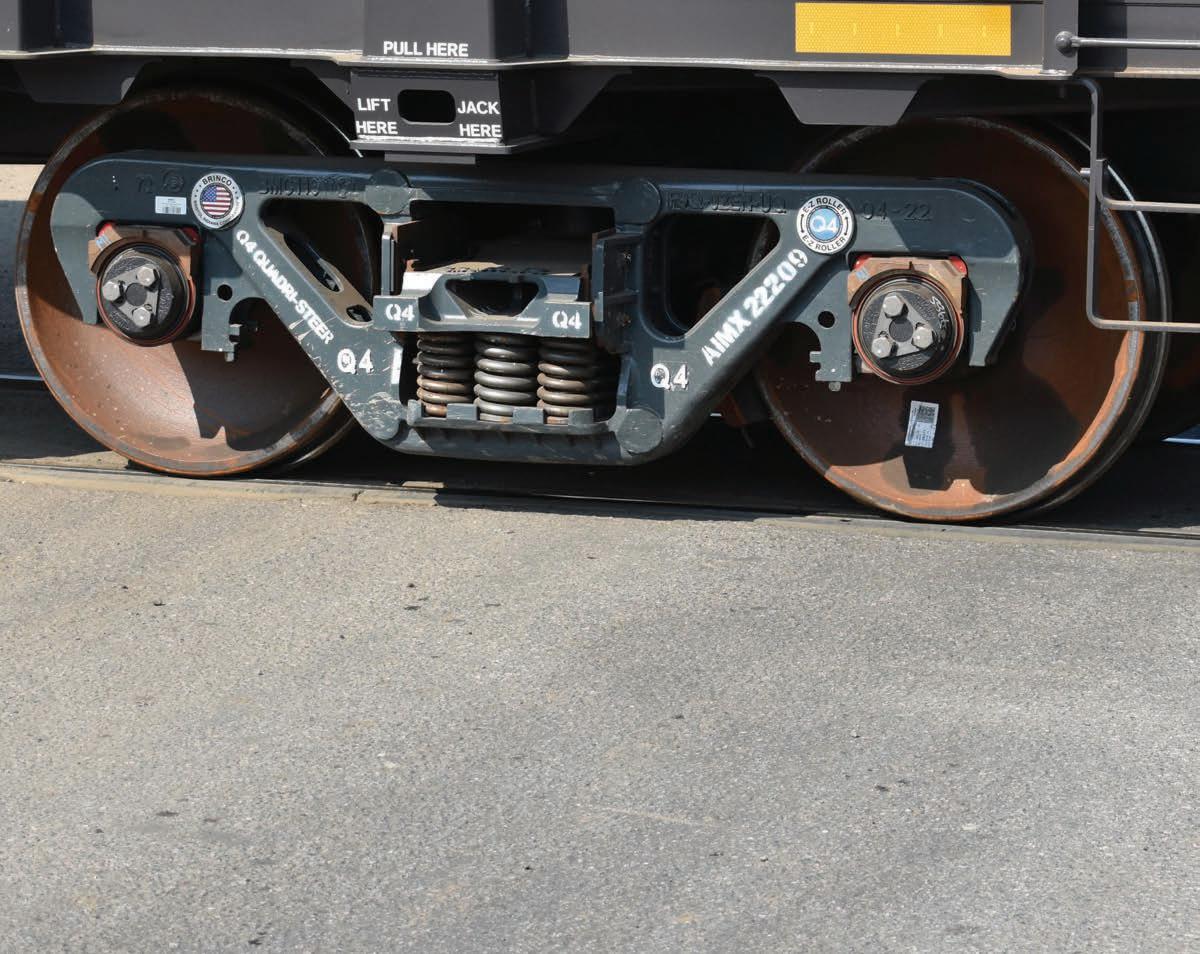









2023 AILWAY G E SERVING THE RAILWAY INDU S TRY S INCE 1856 COMPANY PROFILES 20 RAILROAD FINANCIAL DESK BOOK M ULTI- E DGED D IFFICULTIES
10
By David Nahass, Financial Editor
MULTI-EDG ED DIFFICULTIES
BY DAVID NAHASS, FINANCIAL EDITOR
elcome to the 2023 Railroad Financial Desk Book. The North American rail drama meter has finally backed off from the red line down to a more tepid level of yellow. Granted, North American rail never approached the hyper-intense drama of a titanic battle like Elon Musk vs. Twitter, but the threat of a nationwide rail strike garnered national news cover age and attention for three or four days. Every industry veteran and transporta tion manager answered the probability question at least a dozen times. Want to talk about lost productivity? Think of the number of hours spent developing and sketching out contingency plans by companies providing essential services or running facilities that “can’t” (whether
Wdue to cost or necessity) be shut down. All for naught! Console yourselves—at least you’re prepared for the next time!












Let’s cut to the bare metal: There never was going to be a strike. Whether you believe the executive branch added value or just grabbed the headlines and the credit, the railroads and the unions would have been sent back to the bargain ing table until they found a way to get along. Two words: midterm elections.



The Biden Administration milked the preparation for rail Armageddon shame lessly, going so far as to suggest that they were looking at contingency plans to transfer freight from rail to other modes (as if, “Okay, Joey, just back up that barge to the edge of this rail yard. Yeah, I know there’s no water—just do it!”). There were rumors that calls were placed to Starfleet Command to see if freight


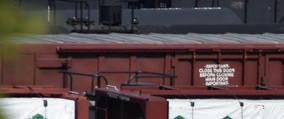

could be “beamed” from location to location to pick up the slack that would have been created by the strike. Given enough time, a reach out to Dreamworks studios to see if they could get some advanced technology on the flying loco motive from “Back to the Future 3” was probably a likely scenario.

Unfortunately, the soap opera around the labor drama became another oppor tunity for a dog pile on the railroads. Late night talk shows had a field day. Jimmy Fallon weighed in on Biden’s political success, The New York Times joined in, and The Wall Street Journal took issue with the strike and with the publicity grab. It’s tough being the butt of the joke.
Vantuono
Of course, this all assumes that the proposal is ratified by the unions. That is not a guarantee. However, certain circumstances bear considering for the William C.
10 Railway Age // October 2022 railwayage.com 2023 FINANCIAL DESK BOOK
Powering your fleet ahead.
CIT Rail leverages deep experience and one of the youngest, most diversified railcar and locomotive fleets in the industry to help you keep your business on track for success. With a long-standing commitment to providing creative railcar leasing solutions, we can help you free up capital for your growth priorities.

Get started today at citrail.com ©2022 First-Citizens Bank & Trust Company. All rights reserved. CIT and the CIT logo are registered trademarks of First-Citizens Bank & Trust Company. MM#12025
Given enough time, a reach out to Dreamworks studios to see if they could get some advanced technology on the flying locomotive from “Back to the Future 3” was probably a likely scenario.

post-strike look at North American rail. Jason Kuehn, Vice President at Oliver Wyman and perennial Rail Equipment Finance speaker, suggests that North American rail’s labor troubles might not end after ratification.
Start with this: Railroad union employees are set to receive a retroac tive “catch-up” payment of back pay going back to Jan. 1, 2020. The current estimate for that payment is an average of $11,000 per employee, including an immediate wage boost averaging more than 14%, plus $1,000 per year in bonus payments. Kuehn raised the question of how many employees have been hanging on for that catch-up payment, and now that the labor war of attrition has come to a close, he wonders how many of the freshly compensated union employees might step up and take the short walk to the exit.
Don’t act all surprised about this. That result would not separate rail from any other industry in a similar position. The question is how senior are the employ ees that may leave and how many may leave in total. Any statistically relevant number would impact whatever prog ress the railroads have made in resolving their current issues.
Kuehn also points out that a national
wage agreement being proposed between railroad and labor creates another poten tial issue. He notes, “Many of the staff ing issues, as we have heard from the railroads, are not systemwide but are location-specific. A national agreement is not a solution that allows carriers to modify pay locally other than things such as one-time hiring bonuses.”
This is a key issue as it relates to improving service in these areas. Kuehn sees it as a critical factor. From recent presentations at Cowen’s annual Trans portation Conference, he recounts CSX noted “that they are facing challenges in New York state” and that Norfolk Southern “called out specific geographi cal areas where staffing is an issue.” He notes Union Pacific and BNSF have had issues centered in California, which is known for higher-than-average wages and cost of living.
Tired yet? Kuehn is concerned there will still be a disconnect when wages are measured against the cost of living in specific locales. These concerns, he notes, “are increasingly becoming problematic in areas where housing prices (and other cost of living categories) are very high.”
Like with the wage-related inconsisten cies, a national wage agreement is not tooled to handle these idiosyncrasies.
As you contemplate the bumps in the road, console yourselves with the hopes that it may be another four years before the rail industry needs to deal with this again.

RAIL R OADS, RAILCA RS AND I NFLATION
The railcar market is tight, and prices for those that lease cars are, in many cases, higher than they’ve been in the past 20 years (see “Around the Market” in this Desk Book, p. 16). Railcar lease rates are high on everyone’s list of interest ing topics on the fall conference circuit, along with inflation and its impact on new railcar prices.
Another topic of great concern to those that lease and own cars ties back to rail service and the ability of the rail roads to originate more carloadings both to serve more customer needs and to grow revenue and strengthen the role of the rails in North America.
Here’s one double-edged problem created by railroad service issues: On one side, it feels like there aren’t enough cars to meet demand. On the other side, there aren’t enough crews, and service on the railroads isn’t good enough to meet the needs of those customers that want to ship by rail.
12 Railway Age // October 2022 railwayage.com




















































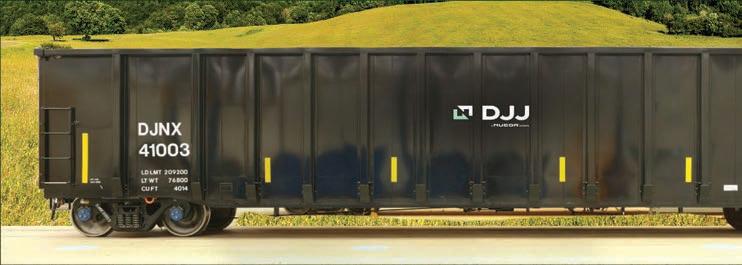


















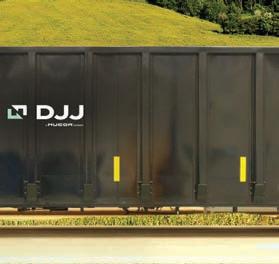
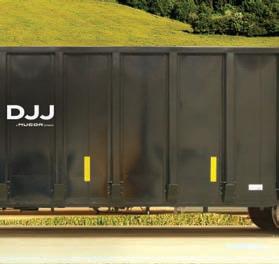















GETTING YOUR SCRAP METAL TO THE MILL DOESN’T HAVE TO BE A GAMBLE With over 135 years of financial strength and stability, DJJ is also known for our creative transportation solutions. Contact us today to discuss private fleet or leasing options. RailGroup@djj.com www.djj.com
Service disruptions are causing some modal shifting of rail loads. It could be a shift to other forms of transportation (most likely truck). In power genera tion, it could cause a decrease in (or put a cap on) the maximum tons of coal that power generators are able to ship by rail. As a result, the volume of coal being burned for consumer or indus trial consumption is being reduced in favor of higher priced (today at least), pipeline-delivered natural gas. These modal shifts create a gap in opportunity cost for a consumer of rail traffic. Ulti mately, that cost gets passed on, directly or indirectly, to the consumer, and that becomes an inflationary pressure.

John Ward, National Coal Transpor tation Association (NCTA) Executive Director and Rail Equipment Finance speaker, notes that in a 2022 NCTA member survey, “More than 80% of respondents reported that they had curtailed power generation to conserve coal; that coal supply commitments for the year were not met; and that coal inventory levels were reduced below target levels.”
For consumer and industrial products
manufacturers, those price increases may not be passed on to their custom ers until six months to a year after the impact starts being felt at the producer level. There is a negative arbitrage period during which the producer carries the additional expense before it gets passed to the next company in the supply chain and on to the consumer. These price impacts might lag inflationary reporting during this negative arbitrage period. In consumer energy markets, the passthrough of lost opportunity is more immediate. On the producer level, the impact is the same timewise as trans portation modal shifts. Congestion on the rails and increasing lease costs due to inefficiency also weigh on these price increases, even as the industry enters its second year of increasing lease costs.
Cost transfer from service disrup tions also happens when facilities that are only rail-served have to temporar ily shut down when they cannot receive feedstock or move product to custom ers. Eamon Monahan, Vice President for Environmental Affairs and Workplace Safety for the Corn Refiners Associa tion (CRA), which represents refiners of
corn that serve the food and animal feed markets (not including ethanol), notes that CRA’s member companies are oper ating at maximum capacity. When railserved facilities are forced to shut down, for however short a duration, that capac ity is lost and is not recoverable. Addi tionally, facilities are not light switches; a shutdown can turn into a multi-day expensive turn of events. Shutdowns stress infrastructure and increase main tenance costs. This additional level of lost opportunity cost is passed down the line and is difficult to measure.
There is no direct measurement of the inflationary impact of these modal shifts that result from railroad-related service disruptions. Clearly this is not the only factor influencing inflation. Its significance rests in the undocumented and unmeasured potential impact. It is important to remember, as Todd Tranausky, Vice President for Rail and Intermodal at FTR Transportation Intel ligence, notes, today’s inflationary cycle was driven first by demand, and that these expenses can’t be passed through as easily when the demand does not exist like it does today.
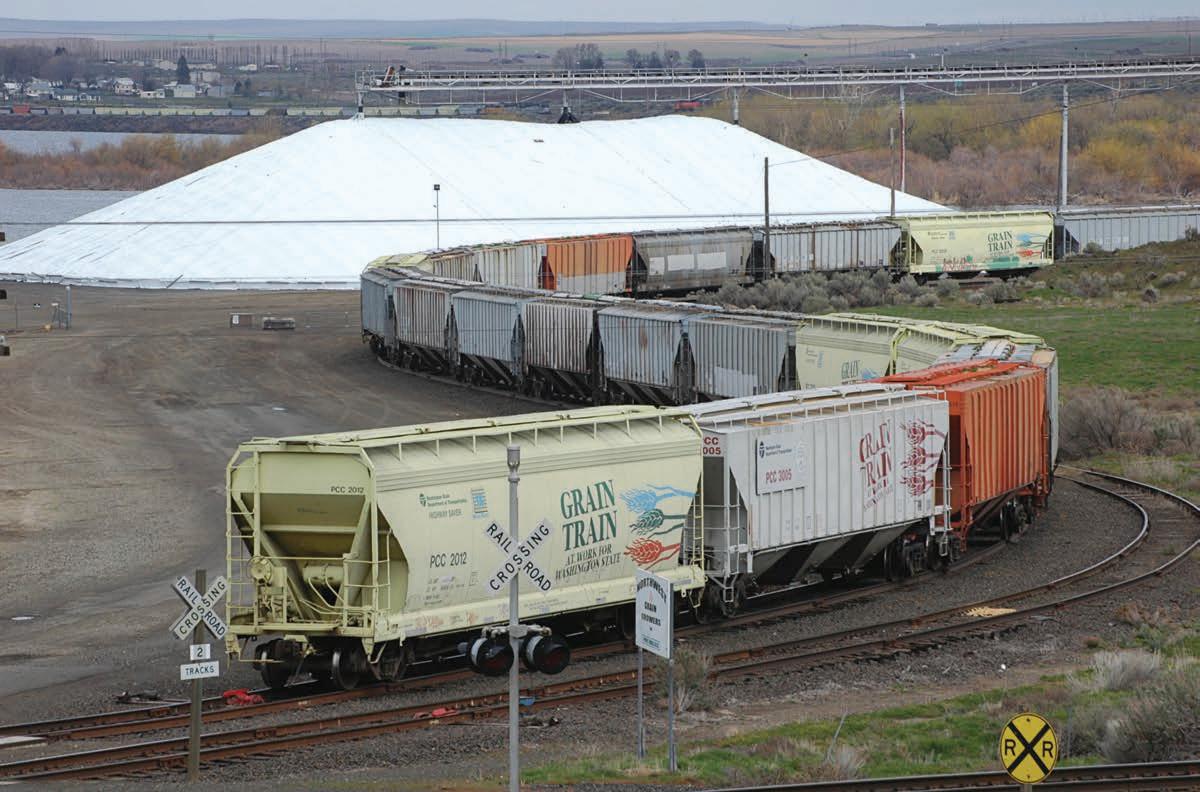
14 Railway Age // October 2022 railwayage.com
Bruce Kelly




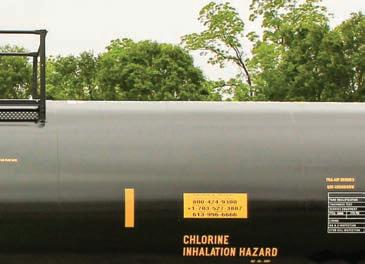




UTLX.COM 855-UTLX-NOW leasinginquiry@utlx.com
In many cases, the individual consumer won’t see the impact of these forces in the CPI (Consumer Price Index) until those prices have been thor oughly incorporated at the retail level (six to even 12 months in some cases). It is one of the challenges behind measur ing the impact.
An interesting pandemic-era parallel is supply chain shifts that may have come up as a result of port congestion on the West Coast. It is still unknown if freight that was shifted from the West Coast to the South or East Coast or that was nearsourced (vs. being sourced in China, for example) will get returned to previous points of origin and destination once congestion eases. Once modal shift has occurred and those supply chain costs are being recovered from the consumer, will companies prevent a shift back to rail (or back to China)? Generally, memories are short, and profit seems to trump all (geez, where have you heard that before?), so a cycle of opportunis tic offshoring and modal shifting back to rail is probably available again at some time in the future.
AROUND THE M A RKET
Leases rates continue to torture lessees and bring smiles to the faces of lessors. There are so many factors driving what is happening in the lease market. It’s service related; it’s being impacted by raw material pricing; and it’s part of the overall economic demand cycle. However, one factor is quickly becoming the straw that stirs the drink. Interest
rates, backed by the Federal Reserve’s need to rein in inflation, have been on the rise. It’s pretty stratospheric. How crazy is it? In May 2021, the one-year Treasury was 0.05%. On Sept. 22, it hit 4.11%. For the 10-year Treasury, it was 0.67% in May 2021 and on Sept. 22 it hit 3.55%. Ouch! That’s a stinger.
Raw material prices, especially hot rolled coil steel, are trending downward. This may provide some relief on new railcar prices, but plate steel continues to trend at high levels. Component-related supply chain issues, especially those that may have been sourced in Russia, continue to be impact factors that affect pricing on all car types.
With scrap sitting in the mid-$200s per ton ($260 as of this writing), the above-average numbers of cars being scrapped has slowed. Longer term, as service improves, expect this to help push down lease rates when car supply frees up a bit.
Back to interest rates: Even after the September 75-basis-point increase in the federal funds rate, the Federal Reserve continues to remain hawkish on further rate increases, and the end of the road does not seem near. The 10-year Treasury, which hasn’t been above 4% since 2008, seems headed there quickly. There’s no easy metric to determine the impact of rising interest rates on lease pricing, as lease rates are a mélange of several factors, but it would be fair to say that the full impact of rising rates has not yet been felt by railcar users. Table set. Gruel served.
Here is what is going on in the lease market:

Covered Hoppers: Grain shipments are down 4.3% YTD, but you wouldn’t know it from lease rates, which are differ ent degrees of high right now. For 4,750cf cars, expect to pay high-$300s ($400s if you don’t mind making enemies on the way up) full service (f/s). For 5,200cf cars, expect numbers to start with a six. Leases are five years f/s. Looking for super jumbos for DDG service? Expect to pay in the low-$700s right now.
Covered Hoppers for Plastic Pellets: “Good luck finding one,” one lessor noted during a recent conversa tion. High-$600s to low-$700s are likely numbers. New cars are being built and continue to be expensive.
Pressure Differential Covered Hoppers: Looking for newer 5,660cf PDs? Expect to pay mid-$800s f/s with terms of five years. Numbers for more out-of-favor smaller cars of 5,200cf capacity are not much better in the high$600s or low-$700s.
Covered Hoppers for Sand and Cement: The Renaissance continues! The problem with a market with so much extra capacity is that the marginal cost of bringing cars into service can occasion ally thin out the pool of available assets. This could be the case for the divergence of rents heard in the market on these cars. The range is from low-$300s to less than $100 f/s, with the majority landing in the mid-$200s.
Tank Railcars: This is probably the segment showing the weakest impact
16 Railway Age // October 2022 railwayage.com 2023
FINANCIAL DESK BOOK
The Right Cars. The Right Services. The Right Partner.

PNW Railcars is a leader in the North American railcar leasing and management business, providing best-in-class railcar asset availability and fleet management, supported by a uniquely talented team that offers decades of combined experience. Our team is committed to serving you and dedicated to helping your business succeed. Visit us at pnwrailcars.com or email info@pnwrailcars.com



2023 FINANCIAL DESK BOOK
of current market tightness. Pressure tank railcars are still seeing some cars in storage and rate in the high-$500s to low-$600s with a fall pickup expected. 25Mg GP tanks are available in the market, and prices have not moved much above the mid-$600 range f/s. Crude oil tanks (117Js) are the best performers, with rates in the $800s. The May 1, 2023 transition date for using DOT111A cars in Ethanol service is approaching fast. According to the Railway Supply Insti tute, as of Dec. 31, 2021, roughly 7,200 DOT111s remain in ethanol service. So expect some jockeying on that front in the near future.

Mill Gondolas: There’s tightness here as well with the shorter 52-foot cars leasing for mid-$600s f/s. If you’re looking for a 66-foot car, expect to pay $700-plus. Some new cars are being built to address demand, but as this is one of the older fleets, expectations for improvement are marginal, even with
low-scrap rates.
Coiled Steel Gondolas: There’s also some building in this segment. New cars in the $130,000 range have lease rates at higher levels. Expect high-$700s to low-$800s for this car if you can find one available right now. For a smaller total fleet, service-related impacts on car supply are amplified.
Centerbeam Flat Cars: There’s some availability in the market for these cars. There is an expectation that the downturn in housing starts may improve availability, but as Dan Anderson from TrinityRail noted at the FTR conference, cars with risers continue to fall further out of favor, even in this tight market. Expect to pay high-$400 to low-$500 per car f/s.
Coal Cars: Coal loadings although up YOY are not as high as they could be. That hasn’t held down lease rates at all for these cars. Lease rates for alumi num gondolas continue to move in the
$300s f/s. As with small-cube covered hoppers, rates are all over the place, with numbers ranging from high-$300s net to the low-$200s f/s. Car availability is an issue here as well. Looking for rapiddischarge cars? Expect the possibility of a slight premium to gon pricing. That is not guaranteed. Availability is scarce here as well.
Boxcars: Tightness in this market continues with high-$600s to low-$700s for both 50- and 60-foot cars. Cars are few and far between, so don’t expect much inventory available. New cars are in the pipeline, but expensive, so expect new car leases to begin with something that looks more like an eight.
It’s clearly a lessor’s market and it’s expected to remain this way for the remainder of the year into the second half of 2023.
LEASING RESOURCE DIRECTORY FOLLOWS

18 Railway Age // October 2022 railwayage.com
To learn how quickly Infinity Transportation can meet your rail needs, contact: Lee Martini lee.martini@gafg.com VP of Sales & Marketing (678) 904-6315 Brian Ottinger brian.ottinger@gafg.com VP of Sales & Marketing (312) 731-2763 Ken Johnson ken.johnson@gafg.com VP of Sales & Marketing (859) 640-0362 Infinity Transportation provides e cient, coste ective leasing and financing solutions for a wide range of clients in rail and intermodal markets. Infinity Transportation LEASING & EQUIPMENT MANAGEMENT Powered by Global Atlantic Infinity delivers: • A large rail fleet comprising an extensive range in car types • Exceptional customer service and flexibility with leases and modifications • An unwavering commitment to finding the transaction and equipment that meets each customer’s specific needs • A team that delivers over 90 years of combined transportation equipment management experience STAY IN GEAR WITH RAIL GROUP NEWS ROUND-UP RAILWA RAIL GROUP NEWS From Railway Age, RT&S and IRJ https://railwayage.com/newsletters RA_RailGroupNews_Fourth_InGear_2022.indd 1 1/10/22 12:43 PM




















SHOULD YOU LEASE OR BUY? Hi-Rail Grapple Truck Nordco TRIPP Mecalac Hi-Rail Mini-Excavator CALL US TODAY. LET’S TALK BUSINESS. 800.962.2902 quotes@RELAMinc.com RELAMinc.com RELAM, Inc. 7695 Bond Street Glenwillow, Ohio 44139 A SIMPLE FRAMEWORK FOR TOUGH DECISIONS • Know the three factors that most impact the lease vs buy decision. • Understand the real cost of ownership vs leasing. • Save capital and invest in innovation. Download the Lease or Buy white paper
2023 FINANCIAL DESK BOOK DIRECTORY
FINANCE COMPANIES
BUNDY GROUP
Bundy Group is a boutique investment bank that specializes in representing business owners and management teams in business sales, capital raises and acquisitions. The firm is a senior-driven orga nization with offices in Charlotte, New York and Virginia. Bundy Group has been a recognized expert in the rail and transportation industry for more than a decade and has numerous successfully closed transactions in the segment. In represent ing a business and its shareholders in exploring a sale or recapitalization, Bundy Group is focused on managing a structured process and delivering premium value for its clients. For more information about Bundy Group’s work in the rail space, please contact Jim Mullens at jim@bundygroup.com or at 540-342-2151. For more information about Bundy Group visit www.bundygroup.com.
ARRANGERS
THE DAVID J. JOSEPH COMPANY
300 Pike Street, Cincinnati, Ohio 45202; Tel.: 513-419-6200; Fax: 513-419-6221; Trey W. Savage, VP Rail Group; Clint Rice, General ManagerRail Equipment Group; Jeff Schmutte, Jeff Blake and Eric Hausfeld, Regional Sales Managers; Dan Dorsey, General Manager-Private Fleet; Steven R. Skeels, Chief Mechanical Officer; and Ann Edwards, Mgr. Retired Rail Assets (502212-7365). The David J. Joseph Company’s Rail Group provides a broad range of transportation services throughout North America: single inves tor, leverage leases, freight cars, portfolio evalua tion, remarketing fleet management, purchases and sales of portfolios, and private fleet manage ment. Other services include freight car inspec tions and engineering services from design of new cars to complete ISL extended life, modifications and analysis; in addition to railcar dismantling for scrapping and parts reclamation.
SEE OUR AD ON PAGE 13
RAILROAD FINANCIAL CORPORATION 676 N. Michigan Avenue, Suite 2800, Chicago, IL 60611; Tel.: 312-222-1383; Fax: 312-222-1470; David G. Nahass, President, Email: dnahass@railfin.com; William J. Geiger, Senior Vice President, Email: wgeiger@railfin.com. RFC represents domestic and international clients in the following areas: debt and lease financing of all railcar types includ ing coal cars, tank cars and covered hopper cars for sand and plastics; railcar and locomotive fleet acquisitions and sales; lease brokerage; mergers and acquisitions; equity and debt financing of rail property acquisitions, fleet and lease restructurings
and/or refinancing. RFC also provides continuing education for the industry.
RR MERGERS & ACQUISITIONS
11 The Pines Court, Suite B, St. Louis, Missouri 63141; Tel: 314 878-1414; Fax: 314-878-1414; Robert Fowler, President, 314 878-1414 x227 Email: robert@rrmergers.com. Jack Sickles, Vice President, 314 878-1414x221 Email: jack@rrmerg ers.com. RR Mergers & Acquisitions has special ized in the sale of rail-focused companies for more than 15 years. Trusted professionals with long-standing relationships in the rail sector, RR Mergers interfaces with strategic and financial buyers finding the right buyer for a Company, to make the best deal happen. While maintaining confidentiality at all times, RR Mergers manages the total process of selling railroad industry suppliers, rail services companies and Short Line Railroads. RR Mergers provides advisory services to prepare the company for acquisition, develop ing a confidential information memorandum, negotiating term sheets, letters of intent and coor dinating the due diligence process.
STRATEGIC RAIL FINANCE
1700 Sansom St., Suite 500, Philadelphia, PA 19103; (215) 564-3122. Michael Sussman, President and CEO. SRF has served for 23 years as trusted advisor to Class I and short line railroads, rail shippers, public sector agencies, and industrial developers. The firm has brought capital, clarity, and velocity to infrastructure development projects in 45 states and Canadian provinces. SRF integrates capital from public programs and private sources with growth marketing strategies and management consulting to position executives toward shortterm objectives and long-term opportunities.
WINTRUST COMMERCIAL FINANCE
3201 Dallas Parkway, Suite 800, Frisco, TX 75034. Tom Forbes, Executive Vice President and Chief Sales Officer. (469) 777-5649 (office); (615) 290-3069 (mobile). Wintrust Commercial Finance (WCF) is Wintrust’s Texas-based, equipmentfocused financing group offering sophisticated loan and lease products to companies through out the United States. Our team offers excep tional customer service and expertise from years of experience providing customers in a variety of industries with innovative capital solutions. WCF funded in excess of $3 billion in equipment-secured loans and leases since our founding in 2015 and has continued to grow into one of the largest equip ment financing companies in the country. WCF is led by an experienced management team with, on
average, 25 years of experience. With the team’s extensive knowledge, we’re prepared to consider all structures, including structured financing and loans; financing for new and used equipment acqui sitions; re-financings and estate planning; capital, operating, synthetic, and TRAC leases; sale/lease back and lease discounting; capital expenditure financing with fixed and floating rates and acqui sitions. For more information, visit http://www. wintrust.com/business-solutions/mid-market/ lending/commercial-finance.html.
LESSORS
THE ANDERSONS RAIL GROUP
1947 Briarfield Blvd., P.O. Box 119, Maumee, OH 43537; Fax: 419-891-2749. Contacts: Joe McNeely, Rail Group President, 419-897-3646; Sean Hankinson, Vice President of Sales, 419-8916352, Sean_Hankinson@andersonsinc.com; Sam Anderson, Vice President of Operations, 419-8914436, Sam_Anderson@andersonsinc.com. The Andersons Rail Group, a part of The Andersons, Inc., has served the rail industry for more than 30 years. The group owns a fleet of nearly 25,000 railcars which it leases to customers handling a wide variety of commodities. It also provides repair, maintenance and component manufac turing services to private railcar owners through its 26 repair shops and steel fabrication facility. With extensive knowledge in taxation, govern ment regulations and railroad requirements, The Andersons Rail Group offers quality products and superior customer service. For more information, visit www.andersonsrail.com.
AMERICAN INDUSTRIAL TRANSPORT INC. (AITX)
100 Clark Street, St. Charles, MO 63301-2075. Tel.: 636-940-6000; Fax: 636-940-6100. Contacts: Sean Hankinson, Chief Commercial Officer, 814-242-6141. shankinson@aitx.com.
American Industrial Transport, Inc. is a leading solutions-provider of railcar services, dedicated to growing our fleet and providing customers a range of options across leasing, fleet management, and repair services. AITX has access to one of the indus try’s most diverse fleets of nearly 60,000 railcars across car-types and commodities-served. Due to their customer service, flexible financing options, and extensive knowledge of taxation, government regulations and railroad requirements, AITX has satisfied leasing customers across freight indus tries. AITX and its subsidiaries operate worldclass railcar repair services through its specialized network spanning across North America. Offering
20 Railway Age // October 2022 railwayage.com
2023 FINANCIAL DESK BOOK DIRECTORY
a range of programs from full to light repair, AITX’s maintenance capabilities include full-service repair facilities, tank car qualifications, a wide footprint of responsive mobile operations, and onsite customer dedicated partnerships. To learn more about AITX’s depth of services and customer commit ment, visit aitx.com.
ATEL LEASING CORPORATION
The Transamerica Pyramid, 600 Montgomery Street, San Francisco, CA 94111; Tel.: 415-6163486; Ken Fosina, Executive Vice President, Email: kfosina@atel.com. Since 1977, ATEL has leased rail assets to America’s largest railroads and shippers. ATEL specializes in the leasing of all types of rail assets, including railcars, locomotives and main tenance-of-way equipment. ATEL targets railcars and locomotives built prior to 2005, but prefers new maintenance-of-way assets. Leases can be full service, but net leases are preferred. ATEL executes lease transactions directly and through its Capital Markets desk. Each year, ATEL’s Portfolio Manage ment will sell rail assets from one of its Funds managing expiration.
CAI RAIL
Steuart Tower, One Market Plaza, 9th Floor, San Francisco, CA 94105. Tel: 415-788-0100; Fax: 415-788-3430. James H. Magee, President, email: jmagee@capps.com; Freddy Fernandez, Vice President-Operations, email: ffernandez@capps. com. CAI Rail is an operating lessor in the new and used railcar space. CAI performs full service, net, per diem and finance leases on all railcar types. We have complete maintenance, engineering, opera tions and field marketing staff. In addition, CAI offers a comprehensive rail car customization and refurbishing program to meet our clients’ specifi cations. Our parent company, CAI International (NYSE: CAI) specializes in container leasing and sales as well as domestic and international intermo dal logistics. So, let’s get moving!
CARMATH, INC.
25965 482nd Ave., Brandon, SD 57005; Walker Carmon, Vice President, Tel.: 605-582-8340; Email: wcarmon@mwrail.com; Website: www. carmathinc.com. At CarMath, we believe every business should have the opportunity to lease quality railcars at a reasonable price. We have the ability to lease both large and small groups of cars with a wide variety of leasing options and will customize a leasing program to best fit your needs.
CIT RAIL 30 South Wacker Drive, Suite 2900, Chicago, IL
60606; Tel.: 312-906-5701. CIT’s Rail division offers a full suite of railcar leasing and equipment financing solutions to rail shippers and carri ers across North America. It manages one of the youngest and most diversified railcar and locomo tive fleets in the industry and leverages its deep experience to empower customers. Contact us to learn how our transportation solutions can power your business. Visit cit.com/rail, call 312-9065701 or follow @CITgroup.
SEE OUR AD ON PAGE 11
C.K. INDUSTRIES, INC. P.O. Box 1029, Lake Zurich, IL 60047-1029; Tel: 847-550-1853; Fax: 847-550-1854; email sales@ ckrail.net. Brian M. Harris. C.K. INDUSTRIES, a privately held corporation, began its U.S. leasing operations in 1980, and offers its services to ship pers, short line, regional and Class I railroads in North America. New investment opportunities up to $10MM of both new and used types of freight cars will be considered. Our existing lease fleet offers a wide variety of car types to meet your lease requirements. We offer mid to long terms, either on a full service or triple net basis.
THE DAVID J. JOSEPH COMPANY 300 Pike Street, Cincinnati, Ohio 45202; Tel.: 513-419-6200; Fax: 513-419-6221; Trey W. Savage, VP Rail Group; Dan Dorsey, General ManagerRail Equipment Group; Jeff Schmutte, Jeff Blake and Eric Hausfeld, Regional Sales Managers; Luke Weatherhead, General Manager-Private Fleet; Steven R. Skeels, Chief Mechanical Officer; and Ann Edwards, Mgr. Retired Rail Assets (502212-7365). The David J. Joseph Company’s Rail Group provides a broad range of transportation services throughout North America: single inves tor, leverage leases, freight cars, portfolio evalu ation, remarketing fleet management, purchases and sales of portfolios, and private fleet manage ment. Other services include freight car inspec tions and engineering services from design of new cars to complete ISL extended life, modifications and analysis; in addition to railcar dismantling for scrapping and parts reclamation.
SEE OUR AD ON PAGE 13
GATX CORPORATION
Thomas A. Ellman, President, Rail North America, GATX Corporation, 222 W. Adams Street, Chicago, IL 60606; Tel: 312-621-6200 Fax: 312-621-6546 GATX is a leader in the rail leasing industry with more than a century of experience, preeminent expertise in specialized railcars, and a growing international presence. GATX meets shipper and
railroad needs with one of the largest lease fleets of tank and freight cars and locomotives in the world. We provide our customers with a unique mix of financial (global financing, valuation, structur ing, leasebacks, joint ventures, partnerships) and mechanical (regulatory, maintenance, engineering, cleaning, inspection) services in North America. Contact via www.gatx.com or 1-800-428-8161.
THE GREENBRIER COMPANIES
One Centerpointe Drive, Suite 400, Lake Oswego, OR 97035; 800-343-7188; Fax: 503-968-4383; Email: Marketing.Info@GBRX.com; Website: www.GBRX.com. Tom Jackson, V.P., Market ing. Greenbrier, headquartered in Lake Oswego, Oregon, is a leading international supplier of equipment and services to global freight trans portation markets. Through its wholly owned subsidiaries and joint ventures, Greenbrier designs, builds and markets freight railcars and marine barges in North America, Europe and Brazil. We are a leading provider of freight railcar wheel services, parts, repair, refurbishment and retrofitting services in North America through our wheels, repair and parts business unit. Green brier manages 445,000 railcars and offers railcar management, regulatory compliance services and leasing services to railroads and other railcars owners in North America. GBX Leasing (GBXL) is a special purpose subsidiary that owns and manages a portfolio of leased railcars that origi nate primarily from Greenbrier’s manufacturing operations. Together, GBXL and Greenbrier own a lease fleet of 8,700 railcars. Learn more about Greenbrier at www.gbrx.com.
INFINITY TRANSPORTATION
Powered by Global Atlantic. 1355 Peachtree Street, NE, Suite 750, Atlanta, GA 30309; Website: www.infinitygafg.com. Lee Martini, VP Sales & Marketing; Tel.: 678-904-6315; lee.martini@ gafg.com; Brian Ottinger, VP Sales & Marketing; Tel.: 312-731-2763; brian.ottinger@gafg.com. Ken Johnson, VP Sales & Marketing; Tel.: 859-6400362; ken.johnson@gafg.com Infinity Transpor tation is a private lessor with a fleet of more than 10,000 railcars of varying types. Lease packages are tailored to meet customer needs, including a variety of short-term operating leases and longterm leveraged leases, as well as other assignment and deployment arrangements. Infinity prides itself on exceptional customer service and flexibil ity with regard to leases and railcar modifications to find the transaction and equipment to best serve our customers.
October 2022 // Railway Age 21 railwayage.com
SEE OUR AD ON PAGE 18
2023 FINANCIAL DESK BOOK DIRECTORY
THE INSTAR GROUP, LLC
2001 Route 46, Ste. 506, Parsippany, NJ 07054. (636), 778-0611; (973) 355-6484. Umesh Choksi, CEO. UChoksi@instargrp.com. The InStar Group LLC is a full-service railcar leasing company estab lished in 2016. We are owner operators and/or investors in the railcar business in North America and provide the highest quality railcars on either a full service or net lease to North American shippers and railroads. We invest and offer all railcar types across all industries we deem to be most efficient for the commodities carried with proven track record of consistent cash flow. We are flexible in our approach to investing in railcars and have the ability to own outright, participate in lease in/lease out arrangements, sale-leasebacks, joint ventures or provide structured financial products for our customers. The InStar Group management team is composed of seasoned industry professionals with manufacturing, leasing, railcar portfolio manage ment, and financing expertise. We maintain rela tionships with all major railcar manufacturers, other operating lessors, shippers, railroads, repair and maintenance facilities and financial institu tions within the industry. The InStar Group, LLC is now part of J.P. Morgan Global Alternatives’ Global Transportation Group, the alternative investment arm of J.P. Morgan Asset Management. More infor mation: https://instargrp.com.
MITSUI RAIL CAPITAL, LLC
One South Wacker Drive, Suite 3110, Chicago IL 60606 - Phone: 312-803-8851: Dan Penovich, President; Chris Gerber, Vice President Sales and Marketing. Mitsui Rail Capital is a railcar operat ing lessor that offers some of the youngest railcars in our industry. From tank cars to covered hoppers to a wide variety of other car types, we deploy assets in every industry, including oil, gas, plastics, agri culture and steel. Our proactive approach enables us to know your unique needs and railcar require ments, getting well-structured deals done, faster. MRC has been in business for 20 years and is a joint venture between Mitsui & Co. Ltd. and JA Mitsui Leasing of Tokyo.
PNW RAILCARS INC.
121 SW Morrison St., Suite 1525, Portland, OR 97204. 503-208-9295. sales@pnwrailcars.com. www.pnwrailcars.com. PNW Railcars, Inc. (formerly MUL Railcars) offers a complete railcar leasing solution set with asset management, regu latory support, and specialized services designed to provide customers with the options they need. PNW Railcars has one of the newest and most comprehensive tank car and freight car fleets in rail
leasing, serving several industries including auto motive, chemical, steel, agriculture, aggregates, construction, infrastructure and intermodal.
SEE OUR AD ON PAGE 17
PROGRESS RAIL, A CATERPILLAR COMPANY
Mike MacMahon, Director of Railcar Leasing, mmacmahon@progressrail.com; Jay Hatfield, Director of Business Development, jhhatfield@ progressrail.com; Gary Lawrence, Manager, Loco motive Sales & Leasing, glawrence@progressrail. com. Jacob Creech, Manager, Locomotive Leasing, jcreech@progressrail.com. Progress Rail, a Cater pillar Company, offers through its Freight Car Leasing Division offer a wide variety of freight cars and leasing options to meet our customers’ specific transportation requirements: Full-Service, Net and Per-Diem leases, and Purchase-Leasebacks. Under standing your needs and supplying an optimal solu tion is what we do best. The Locomotive Leasing Division offers Full-Service Leases: Net, Seasonal, Sell-Lease Back, Trade-Ins. All locomotives sold or leased go through an extensive inspection to ensure you are receiving equipment that is ready for service. Refurbishment or upgrades are avail able to ensure the locomotive fits your operation, with work completed in our own shops under our supervision, ensuring the highest level of quality. Through the acquisition of Electro-Motive Diesel, Progress Rail has access to locomotive information other providers cannot supply. Our locomotive inventory is constantly changing, as we strive to be your top supplier of quality and dependable used locomotives.
SEE OUR AD ON THE INSIDE FRONT COVER
RELAM (RAILWAY EQUIPMENT LEASING AND MAINTENANCE) INC.
7695 Bond Street, Glenwillow, OH 44139; (440) 439-7088. John Roberts, CEO, Email: jroberts@ relaminc.com. As a full-service leasing company, we offer complete MOW equipment leasing services. Each of our team members is knowledgeable, professional, prompt and courteous, one reason why our clients stay with us. We understand the importance of making every business transaction easy on the customer. We handle all the paperwork and logistics for every lease, so you can spend your time on more important things. We are commit ted to providing our clients with the highest level of service while remaining competitive in today’s market. RELAM knows railroad operations and the equipment involved.
SEE OUR AD ON PAGE 19
RALTRAC, LLC
200 S. Wacker Drive, Suite 3100, Chicago, IL 60606; tel: 312-674-4742; fax: 312-421-2742; www.raltrac. com. RALTRAC (formerly RALCO) is a privately held, Illinois Limited Liability Company in the business of acquiring, managing and leasing rail road rolling stock on net or full services leases. The Company has the intellectual and financial resources necessary to compete in the small cap lease market where its size and structure provide it with a competitive advantage. RALCO also provides consulting and advisory services to its clients. Contact: Peter Urban, Principal, purban@ raltrac.com, 847-975-3568 (mobile); Richard Johannes, Principal; Jason Urban, Principal.
RELCO LOCOMOTIVES, INC.
One Relco Ave, Albia, Iowa 52531. Tel.: 641-9323030; Website: www.relcolocomotives.com. RELCO, as one of North America’s leading locomo tive rebuild, remanufacturing and leasing compa nies, can provide a full range of locomotive leasing and maintenance services. Since 1961, RELCO has developed a reputation for providing the finest motive power and custom maintenance packages to fit any need:
• Full line of both switching and road power available.
• Specifications ranging from qualified to completely custom remanufactured.
• Aftermarket systems upgrades available, including radio remote controls, micropro cessor control systems, fuel management systems, etc.
• Nationwide full-maintenance programs available.
• Net, full-service, financial and sale/leaseback programs.
SMBC RAIL SERVICES LLC
300 South Riverside Plaza, Suite 1925, Chicago, IL 60606; Mike McCarthy, President & CEO (312) 559-4803; Tina Beckberger, Senior Vice President Leasing, (312) 559-4818. SMBC Rail Services is a full-service operating lessor, invested in all tank and freight car types, offering a broad selection of equipment leasing and financing products for the North American rail market. SMBC Rail can struc ture a solution for all your rail equipment needs, short and long term, full-service or net leases, sale/ leasebacks, or portfolio acquisitions. Contact us via www.smbcrail.com or sales@smbcrail.com.
TEALINC, LTD.
1606 Rosebud Creek Road, Forsyth, MT 59327; Tel.: 406-347-5237; Fax: 406-347-5239; www.tealinc.
22 Railway Age // October 2022 railwayage.com
2023 FINANCIAL DESK BOOK DIRECTORY
com; webmail@tealinc.com; Julie Mink, President, 720-733-9922; julie@tealinc.com; Kristen Kempson, Director-Railcar Leasing & Sales; Tel. (708) 854-6307; kristen@tealinc.com; Shannon Rodgers, DirectorOperations; Tel.: (814) 631-9277; shannon@tealinc. com. Tealinc, Ltd. is a boutique private freight railcar lessor, railcar fleet manager and rail transportation consultant. Guided by our Customer-Centric philos ophies, we partner with our customers by leasing, buying, and selling railcars nationally and interna tionally. Our private railcar fleet includes covered hoppers, flatcars, gondolas, open top hoppers, etc. Custom-tailored railcar lease support packages include options such as daily tracing, cycle time reports, preventative maintenance planning, etc. Our rail transportation consulting services enable our customers to have a successful freight-by-rail experi ence. With a combined 80 years providing service and expertise in the freight rail industry, the Tealinc team is dedicated to being a rail partner to novice, interme diate, and expert freight railcar shippers.
TRINITYRAIL®
14221 North Dallas Parkway, Ste. 1100, Dallas, TX 75254. 1-800-631-4420. TrintyRail® provides access to the rail transportation businesses of Trinity Industries, Inc. With an owned and managed fleet of approxi mately 131,000 railcars, Trinity Industries Leasing Company (TILC) provides one of the largest railcar fleets in North America. In addition to comprehensive leasing and management services, our customers have access to extensive manufacturing and engineering resources, railcar maintenance, parts, asset manage ment and advisory services, and on-site field support for operational assistance and training. An overview of our platform of integrated rail products and services is available at www.trinityrail.com.
SEE OUR AD ON PAGE 3
UNION TANK CAR COMPANY
175 W. Jackson Blvd., Suite 2100, Chicago, Illinois 60604; 312-431-3111; leasinginquiry@utlx.com; https://www.utlx.com. Union Tank Car Company (UTLX) supplies general purpose and pressure tank cars, in addition to plastics covered hopper cars, for bulk shippers. Along with Canadian affiliate Procor Limited (PROX), our combined companies own the largest and most diverse tank car fleet in North America, specializing in full-service tank car leasing. We also operate the largest railcar repair network on the continent, and with the acquisition of Transco Railway Prod ucts Inc. in 2019, our repair network now includes 26 full-service shops and more than 100 mini shop and mobile unit installations. UTLX is capable of servicing all fleet management and maintenance
needs for all car types. Our manufacturing opera tion, located in Alexandria, Louisiana, specializes in the fabrication of tank cars. Leveraging an inte grated leasing-repair-manufacturing model with experience cultivated throughout our 130-year history, our talented team provides superior customer service and shapes the future of the highly regulated North American tank car indus try. Union Tank Car Company is a Marmon/ Berkshire Hathaway Company.
SEE OUR AD ON PAGE 15
VTG RAIL INC.
103 West Vandalia, Suite 200, Edwardsville, IL 62025. Bryan Vaughan, Regional Vice President Sales, 630-361-6745, Bryan.Vaughan@vtg.com. Lynn Hayungs, Regional Vice President, Sales, 956-630-2723 ext. 206, Lynn.Hayungs@vtg.com. VTG is a freight and tank railcar lessor offering operating leases and customer structured solutions. VTG also provides fleet management services for its customers and for other private railcar owners and operators. VTG is a customer service oriented leasing company that provides a best in class mix of service, operational and mechanical expertise at competitive lease terms. VTG invests in all freight car types.
WELLS FARGO RAIL
Wells Fargo Rail, 9377 W. Higgins Road, Suite 600, Rosemont, IL 60018; Telephone: 844-459-9664; Fax: 847-318-7588; Web: www.wellsfargo.com/rail. Email: RailAccountServices@wellsfargo.com. Wells Fargo Rail is the largest, most diverse rail equipment operating lessor in North America. Whatever you’re transporting, we’ve got you covered with more than 175,000 railcars and 1,800 locomotives. Our team of experienced rail industry professionals is ready to listen to your needs and structure creative solutions to add value to your business.
PROFESSIONAL SERVICES
RAILROAD APPRAISAL ASSOCIATES
Division of The Occor Company; Management Consultants providing a variety of consulting services to the railroad and urban transportation industries and the financial institutions and leasing companies that serve them: Railcar and Loco motive Appraisal & Inspection Services for New and Used Equipment, Rail Equipment Portfolio Reviews and Valuation, Market Studies, General Consulting. We have more than 20 years of market experience and data. Patrick J. Mazzanti, President; Ronda Lemons, Assistant. Headquarters: 1914 Springdale Drive, Spring Grove, IL 60081, (815) 675-3300; E-mail: pat@railroadappraisals.com.
RAILSOLUTIONS, LLC
1401 Walnut Street, Suite 500, Boulder, CO 80302; (646)258-5812. 2593 Wexford-Bayne Road, Suite 205, Sewickley, PA 15143; (724) 766-6699; Email: mmahoney@railsolutions-llc.com, rblankemeyer@ railsolutions-llc.com; Website: www.railsolutionsllc.com; Michael E Mahoney, President; Robert Blankemeyer, Senior Vice President. RailSolutions LLC provides a broad variety of railroad equipmentrelated consulting, technical and advisory services to financial institutions, railroads, shippers and fleet owners with a primary focus on equipment valua tion and appraisal services. RailSolutions LLC offers two publications on a subscription basis, The Inves tors’ Guide to Railroad Freight Cars and Locomotives and the RailSolutions Railroad Equipment Historical Database. Our firm draws on close to 50 years of rail road industry experience in railcar and locomotive equipment valuations supported by both a sound base of market data and advanced analytical techniques.
SEE OUR AD ON PAGE 16
RR MERGERS & ACQUISITIONS
11 The Pines Court, Suite B, St. Louis, Missouri 63141; Tel: 314 878-1414; Fax: 314-878-1414; Robert Fowler, President, 314 878-1414 x227 Email: robert@ rrmergers.com. Jack Sickles, Vice President, 314 878-1414x221 Email: jack@rrmergers.com. RR Mergers & Acquisitions has specialized in the sale of rail-focused companies for more than 15 years. Trusted professionals with long-standing relation ships in the rail sector, RR Mergers interfaces with strategic and financial buyers finding the right buyer for a Company, to make the best deal happen. While maintaining confidentiality at all times, RR Mergers manages the total process of selling railroad indus try suppliers, rail services companies and Short Line Railroads. RR Mergers provides advisory services to prepare the company for acquisition, developing a confidential information memorandum, negotiat ing term sheets, letters of intent and coordinating the due diligence process.
STRATEGIC RAIL FINANCE
1700 Sansom St., Suite 500, Philadelphia, PA 19103; (215)564-3122. Michael Sussman, President and CEO. SRF has served for 23 years as trusted advisor to Class I and short line railroads, rail shippers, public sector agencies, and industrial developers. The firm has brought capital, clarity, and velocity to infrastructure development projects in 38 states and Canadian provinces. SRF integrates capital from public programs and private sources with growth marketing strategies and management consulting to position executives toward shortterm objectives and long-term opportunities.
October 2022 // Railway Age 23 railwayage.com
HOLD ON TIGHT!
BY CAROLINA WORRELL , SENIOR EDITOR
Rail fastening system suppliers continue to find new ways to deliver a tight hold and longer track life, helping to ensure the safety of heavy-haul, high-speed passen ger rail and transit applications across North America and beyond.


There are numerous ways to fasten a rail to a crosstie. Traditional spikes and a wide variety of clips are available to suit any application. Gauge-holding capability, resiliency, noise reduction, ease of instal lation and maintenance, low life-cycle cost, safety: Railroads rely on fasteners with these qualities from such suppliers as Alcoa, MxV Rail, L.B. Foster, Howmet, Lewis Bolt and Nut Company, Pandrol, Progress Rail, J.Lanfranco, Kawasaki
Track Technologies and Vossloh North America to perform reliably and safely under heavy traffic ranging from heavyhaul freight to high-speed passenger rail to transit.
To meet these requirements, suppliers continue to make incremental updates to their system technologies. Railway Age contacted fastening system suppliers to find out about their latest technologies, as well as market conditions following the COVID-19 pandemic.
“The market remains strong follow ing a slowdown due to the pandemic,” says Kawasaki Track Technologies. “The global semi-conductor shortage has had an impact on sourcing. However, Kawasa ki’s global market presence has been able to manage through the shortage.”

“In 2022, we saw steel prices spike,” adds Lewis Bolt and Nut Company Assis tant Vice President, Sales George Apos tolou. “We are fortunate, however, to be a domestic manufacturer that does not rely on foreign steel, allowing us to better control sourcing of materials used to manufacture our products.”
Following is a roundup of offerings from suppliers who responded to our inquiries.
KAWASA K I TRAC K TECHNOLOGIES
Kawasaki Track Technologies, which “utilizes the latest machine vision and machine learning technologies to inven tory fasteners and detect potentially defective fasteners,” announced in May 2022 the start of testing of a track fastener
24 Railway Age // October 2022 railwayage.com
Track
TECH FOCUS — M/W
Kawasaki
Technologties
Kawasaki Track Technologies’ track fastener monitor employs cameras and global positioning sensors to identify potential defects with track fastening systems.
monitoring technology in Japan. This technology, the company says, while installed on a locomotive, will “capture high-resolution pictures and provide the necessary data for Kawasaki to utilize machine learning algorithms to identify potential track fasteners that need to be inspected and repaired.”
Kawasaki employs cameras and global positioning sensors to identify poten tial defects with track fastening systems. When the system is complete, it will provide near real-time exceptions to its customers to plan maintenance, Kawa saki says.
Kawasaki plans to roll out similar testing in the North American freight rail industry this fall/winter and says it will begin piloting the monitoring system in
early 2023. This technology, according to the company, will “continue to expand Kawasaki’s autonomous track inspection technology to enhance railroad safety and operating efficiencies.” Kawasaki currently has a locomotive-mounted autonomous track geometry monitoring system that has been in production since 2021.
“Demand for innovative products that improve safety and operating efficien cies continue to have high demand in the North American freight marketplace,” says Kawasaki, adding that it expects this to continue in 2023 as more federal funding becomes available.
PROGRESS R AIL
From rail anchors and all styles of clips to DF (direct fixation) and ballast mats,



to turnouts, lift frogs and crossovers for transit, commuter and HAL (heavy axle loading) applications, Progress Rail, a Caterpillar company, supplies a full line of fastening and special trackwork solu tions for heavy-haul and transit railways, offering “one of the broadest fasten ing product portfolios in the world.” By delivering innovative options, such as the e-Style Clip, the resilient Loadmaster DF for timber ties and the ADFF55 high attenuation DF fastener, Progress Rail says it supports its customers’ efforts to “improve efficiency, service quality and cost control.”
For example, according to the company, the DF Block System dramati cally improves the quality of DF fastener installations for both standard and high

— M/W October 2022 // Railway Age 25 railwayage.com
TECH FOCUS
Lewis Bolt and Nut Company Viper-1® rail anchor.
L.B. Foster vulcanized rubber bonded DF fastening system.
Lewis Bolt & Nut Company; L.B. Foster
attenuation units. The product, Progress Rail says, eliminates the risk of irregular support surface conditions, honeycombs in the concrete, and improper elevation setting of concrete embedded insert.
According to Progress Rail, on the Los Angeles Westside Purple Line Section 1, the DF Block system has reduced installation time with less material handling and fewer personnel required for the same work. The DF Block System “improves life expectancy of DF units, reduces maintenance, and provides a significant initial installation savings as compared to the 30-plus-year-old, top-down construction technique,” the company tells Railway Age.
MXV RAIL
When asked about the latest in technol ogy that it is using regarding its fastening
systems, MxV Rail Senior Engineer II Yin Gao told Railway Age that the company “continues to test elastic fastening systems for wood ties as they are gaining popularity in the freight railroad industry for their high-resistance of rail rollover and gauge widening, especially on highdegree and high-grade curves.”
“We are also testing a new design of rail pad assembly that is for quick installa tion after worn metal shoulder repair for concrete ties,” Gao adds.
L
.B.
FOSTE R
L.B. Foster Company has been supply ing vulcanized rubber bonded DF fasten ing systems to transit agencies across the U.S. and Canada for more than 40 years. The company’s Transit Products Division “specializes in the design and develop ment of noise and vibration mitigation
and electrical isolation technologies for use in transit, commuter rail and freight applications.”

L.B. Foster offers a line of more than 50 fastening systems, each “uniquely designed” to offer varying stiffness and resiliency, rail seat width and height accommodations, lateral adjustment, and anchoring locations in a “single, easy-to-install unit,” the company says. “Our engineering team partners with our customers to design new fastening appli cations to meet their specification and design requirements,” L.B. Foster tells Railway Age
Additionally, L.B. Foster’s research and development team is currently prototyping and testing new versions of high-resilient DF fastening systems, “offering greater noise and vibration mitigation than standard fasteners,” the company says.
“Our teams are researching specialty coatings to extend the life expectancy of fastening systems used in highly corrosive environments. We are also working on designs for our low vibration track (LVT) ties to enhance their performance and prevent debris and water intrusion into the boot and pad areas,” L.B. Foster tells Railway Age.
LEWIS B OLT AND NUT CO M PANY
Lewis Bolt and Nut Company’s most recent product launch is the Viper-1® drive-on anchor, says Apostolou, who adds that the Viper-1® exceeds American Railway Engineering and Maintenanceof-Way Association (AREMA) Chapter 5, Section 7.1.4 requirements and has a
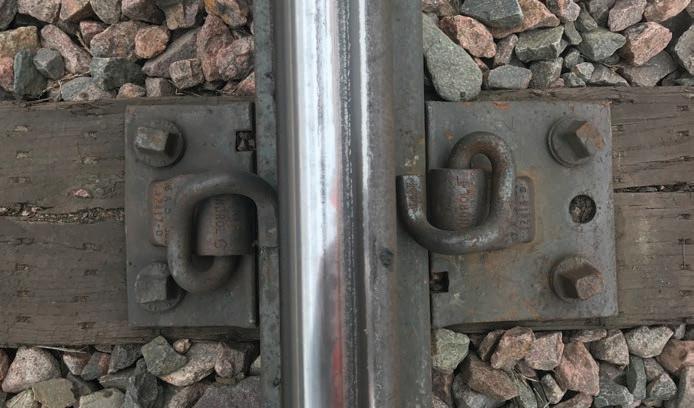
26 Railway Age // October 2022 railwayage.com TECH FOCUS — M/W MxV Rail
MxV Rail continues to test elastic fastening systems for wood ties.
minimum holding power of 9,000 pounds vs. 6,000 pounds (AREMA 7.1.4, Part B).
In addition, the Viper-1® has a much higher re-application rate than any current anchors on the market, Apos tolou says. The anchor can be removed and reapplied multiple times because of improved stiffness in the design of the anchor jaw.



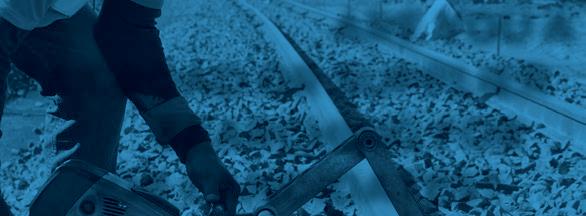
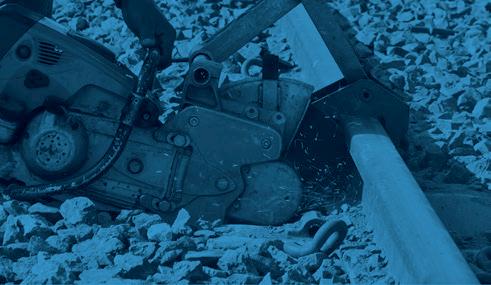



Another key benefit of the Viper-1®, Apostolou says, is the larger bearing surface against the tie. The Viper-1® boasts 75% more bearing surface than standard drive-on anchors. This results in increased tie life preventing movement and damage to the tie surface. In addition, Viper-1® offers an increased life cycle that is designed to last the life of the rail, Apostolou adds.
Lewis Bolt and Nut Company has two dedicated stand-alone facilities manu facturing a variety of anchors domesti cally. The company continues to work on incremental product improvements for customers and has been looking internally

to make its manufacturing process more efficient, Apostolou says.
When asked to comment on the company’s overall business outlook given the availability of federal money, Apos tolou said, “It is just very difficult to
forecast any outlook moving forward into 2023, given the current global economic climate,” adding, however, that the company “continues to communicate with its customers for any signs of weak ness or strength going forward.”
TECH FOCUS — M/W Progress
October 2022 // Railway Age 27 railwayage.com
Rail
Progress Rail’s DF Block System “dramatically improves the quality of DF fastener installations for both standard and high attenuation units.”
ARE YOU A RAILROAD OR SUPPLIER SEARCHING FOR JOB CANDIDATES? Visit http://bit.ly/railjobs AILWAY GE To place a job posting, contact: Jerome Marullo 732-887-5562 jmarullo@sbpub.com RA_JobBoard_Half.indd 1 5/24/22 10:03 AM
METROPOLITAN MARVEL
The New York Metropolitan Transportation Authority (MTA) is the world’s largest, with operating and capital budgets that rival those of Class I railroads, and ridership on its giant rapid transit network, MTA New York City Transit, and two regional/commuter rail systems, MTA Metro-North Railroad and MTA Long Island Rail Road (LIRR), of some two billion trips, annually.
Those impressive numbers, of course, are pre-COVID-19. Ridership fell off a cliff,


as expected, during the pandemic, but is making a steady recovery. The MTA has benefitted from a major infusion of federal pandemic relief funds, much of it for opera tions, but that money will be exhausted within the next couple of years. But major capital programs, financed through the agency’s five-year plans, as well as federal dollars, are making steady progress, boosted now by funds from the Biden Administra tion’s IIJA (Infrastructure Investment and Jobs Act), also known as BIL (Bipartisan Infrastructure Law).

Following are several examples of how the MTA, truly a “metropolitan marvel,” is building for the future—with BIL helping pay the bills—to create a more-cohesive, unified system with multiple route options, and greater flexibility and resiliency.
GRAND CENTRAL MADISON
The LIRR’s $11.1 billion project to bring service to Manhattan’s East Side is expected to start by the end of this year. Riders will travel to a new 700,000-square-foot LIRR terminal, which is virtually complete and


28 Railway Age // October 2022 railwayage.com
now called Grand Central Madison.
Construction of what had been called the East Side Access (ESA) project—originally conceived in the 1960s and developed in the 1990s—began in 2006, and represents the largest expansion of LIRR service since the original Pennsylvania Station and its East River Tunnels opened Sept. 8, 1910. The project includes Grand Central Madison, located under Grand Central Terminal, which currently serves MTA Metro-North Railroad and MTA New York City Transit. The new connection is expected to double
BY WILLIAM C. VANTUONO, EDITOR-IN-CHIEF
LIRR capacity into Manhattan, with up to 24 trains per hour, and cut travel time for Queens, N.Y., riders by 40 minutes per day.
LIRR trains will approach Grand Central Terminal through a new double-track tunnel under the East River at 63rd Street. The two tracks double to four and again to eight on Grand Central Madison’s two levels. Grand Central Madison includes more than 40 track-miles and nearly 13 miles of newly excavated tunnels, with 44 ventilation fans, 550 miles of cable, 975 security cameras, 15 overhead wayside signal structures, and 14
signal bungalows. A new yard in Queens has been built to accommodate up to 300 railcars, and LIRR’s Harold Interlocking has been updated, including installation of 97 new turnouts, 295 catenary poles used by Amtrak, five new steel railroad bridges, and 8,445 feet of retaining walls.


METRO-NORTH PENN STATIO N ACCESS

The Metro-North Penn Station Access project is something that has been discussed (some say argued over) for years by LIRR,

October 2022 // Railway Age 29 railwayage.com
Joseph M. Calisi
The world’s biggest transit agency is bouncing back, in a big way.
Reliability









CCB-II is a member of the industry-leading MaxCONTROL family of brake systems and is installed on more than 34,000 heavy haul locomotives worldwide.
Best-in-class reliability: CCB-II’s selfdiagnostics continuously monitor system pressures, signals and on-board processors to reduce mission failures to less than one occurrence per 200 locomotive years.

Continuous improvement: Innovations include an ER reduction feature on our nextgeneration Electronic Brake Valve (shown above) and a host of upcoming improvements, including Auto Flow Calibration and new diagnostic functionalities.

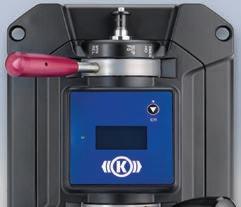
Coupled with NYAB’s state-of-the-art engineering and a dedicated CCB support center, it’s no wonder our CCB units are installed on a majority of AAR locos around the globe.
Contact Roger Evans at 315.786.5214 to learn more about the bene ts of today’s CCB-II and what enhancements are coming down the line tomorrow.
Metro-North, NJ Transit and Amtrak. But, now, the “territory squabbles” have been mostly worked out. In 2019, Amtrak’s Board of Directors approved an agreement with the MTA that paved the way for the new service. RailWorks Transit LLC, in a joint venture with Halmar International, has been awarded the design-build contract.
The project will bring Metro-North commuter rail service to Penn Station and Manhattan’s West Side, along Amtrak’s Hell Gate Line on the Northeast Corridor, giving riders a choice between that and Grand Central Terminal. Also included in the project are four new stations in the East Bronx—at Hunts Point, Parkchester, Morris Park and Co-Op City—which would be part of the New Haven Line. At Penn Station, riders from Connecticut, Westchester and the Bronx would be able to connect with LIRR, New Jersey Transit, Amtrak, Port Authority Trans-Hudson Corp. (PATH), and MTA New York City Transit subway and bus services. According to MTA, the commute from Co-op City to Penn Station would be reduced from 75 to 25 minutes, and the commute from Hunts Point to Penn Station would be cut from 45 to 16 minutes.

four new Metro-North stations, which will bring increased regional accessibility to the eastern Bronx communities.
Metro-North Penn Station Access, slated for completion in 2027, “will expand service options and accessibility for hundreds of thousands of Metro-North commut ers,” RailWorks President and CEO Kevin Riddett said. “RailWorks is proud to partner with Halmar International on this crucial project, and we look forward to seeing it fully completed”—as will thousands of Metro-North customers who work on the West Side of Manhattan
LIRR TH IRD MAIN LI NE TR ACK
The LIRR opened the 2.5-mile second section of its new Main Line Expansion (Third Track) project between the Meril lon Avenue and Mineola stations on Aug. 29. “Just two weeks after opening the first section of the Third Track (Floral Park to Merillon Avenue), we’re celebrating the next step in the MTA’s historic, multi-billiondollar investment into the LIRR,” said MTA Chair and CEO Janno Lieber. “Third Track, along with Grand Central Madison, will allow the LIRR to increase service by 40%.”
315.786.5200 | www.nyab.com
Working in partnership with Halmar, RailWorks Corporation’s New York-based transit division, RailWorks Transit LLC, will design and construct additional passenger tracks, traction power substations, overhead contact systems, new interlockings, updated communication systems, and new signal systems within Amtrak’s right-of-way. The contract also includes construction of the
MTA noted that this project is “a major part of an unprecedented multi-billion-dollar investment in 100 projects to transform and modernize the LIRR” that also includes Grand Central Madison; construction of a more spacious Penn Station LIRR Concourse and a new entrance at 33rd Street; renewal and upgrading of 36 stations and 17 bridges; elim ination of eight at-grade railroad crossings; New York
30 Railway Age // October 2022 railwayage.com
MTA
The LIRR opened the 2.5-mile second section of its new Main Line Expansion (Third Track) project between the Merillon Avenue and Mineola stations on Aug. 29.
E₂O : Engineered
to Outperform
made CCB-II MaxCONTROL Classic the industry leader.
Our drive to innovate means we’re not stopping there.
addition of 13 miles of second track between Farmingdale and Ronkonkoma; upgrades to 15 electrical substations; parking capacity increases; and railyard expansions.
NY PENN RECONSTRUCTION
Moynihan Train Hall, the second phase of the larger New York Penn Station Recon struction project, will, after years of fits and starts punctuated by political squabbles, finally open for LIRR and Amtrak service Jan. 1. The $1.6 billion project, which reno vated the 100-year-old James A. Farley Post Office Building at 8th Avenue across from Penn Station, wraps up Dec. 31. Named for the late U.S. Sen. Daniel Patrick Moynihan, who represented New York for 24 years and championed the project, it expands Penn Station’s concourse space by 255,000 square feet, or 50%.
New York Penn Station Reconstruction’s first phase, completed in 2017, included a new $300 million, 400-foot-by-400-foot concourse with direct access to the western end of platforms for 17 of Penn Station’s 21 tracks. Moynihan Trail Hall, a public-private partnership among Empire State Develop ment, Vornado Realty Trust, Related Compa nies, Skanska, LIRR, Amtrak, and the Port Authority of New York and New Jersey, has been delivered via a design-build partnership.
A design and engineering contract to complete New York Penn Station Recon struction has gone to a joint venture led by FXCollaborative Architects LLP and WSP USA Inc., with British architect John McAslan + Partners as a collaborator. MTA, in partnership with NJ Transit and Amtrak, announced approval of the contract on Sept. 21. The RFP was released in June.
The FXCollaborative and WSP joint venture developed the Penn Station Master Plan, which was unveiled last year. It evalu ated alternatives and created the preferred redesign plan for Penn Station as a singlelevel facility centered around a train hall with a 450-foot long sky-lit atrium between Madison Square Garden and 2 Penn Plaza. The design “will relieve overcrowding and improve passenger flow and orientation; improve safety by increasing platform and station egress and accessibility; alleviate the ‘cramped, disjointed circulation areas with widened concourses and high ceilings’; create a clear street presence that integrates with the surroundings”; optimize retail and
other revenue generation; and integrate Penn Station with Moynihan Train Hall and the planned Penn Station expansion,” MTA said.

The recommendation for the design joint venture followed an open, competitive RFP process that attracted five proposals from firms and joint ventures that were reviewed and scored by representatives from MTA Construction & Development, Amtrak and NJ Transit, and assisted by a Technical Advisory Committee with additional repre sentatives from LIRR, Empire State Devel opment and the New York City Economic Development Corp.
A base contract of up to $57.9 million will develop the preliminary station design and will last for one year. This contract includes options covering preliminary design for improvements to nearby NYCT subway stations, and design and engineering support as the station reconstruction moves forward. Additionally, MTA’s Department of Diversity and Civil Rights assigned a 22.5% DBE (Disadvantaged Business Enter prises) goal to the contract.
“We are excited to recommend a team that has a track record of designing proj ects that achieve world-class design excel lence while improving safety and being constructible, our singular focus as we seek to finally give Penn Station’s 600,000 daily riders the station they deserve,” MTA C&D President Jamie Torres-Springer said.
“The work will take place on an aggres sive timetable,” Janno Lieber added. “The opening of Grand Central Madison provides us with a once-a-century opportunity to rebuild Penn Station. With a sizable percent age of LIRR riders expected to shift their trips to Grand Central Madison, Penn Station will have five years with lower customer volumes before a new influx of customers arrives on Metro-North by 2027. The MTA wants to get the most disruptive of the work done before then, so I’m thrilled we are moving forward quickly with the design phase of this massive, long-delayed effort.”
The full project is estimated to take five to six years to complete and comes with a price tag of $6-$7 billion.
October 2022 // Railway Age 31 railwayage.com
NEW YORK MTA
www.hatch.com
Proudly supporting the agencies of the New York MTA.
THE WAY FORWARD
Next-generation train control is on an evolutionary track.
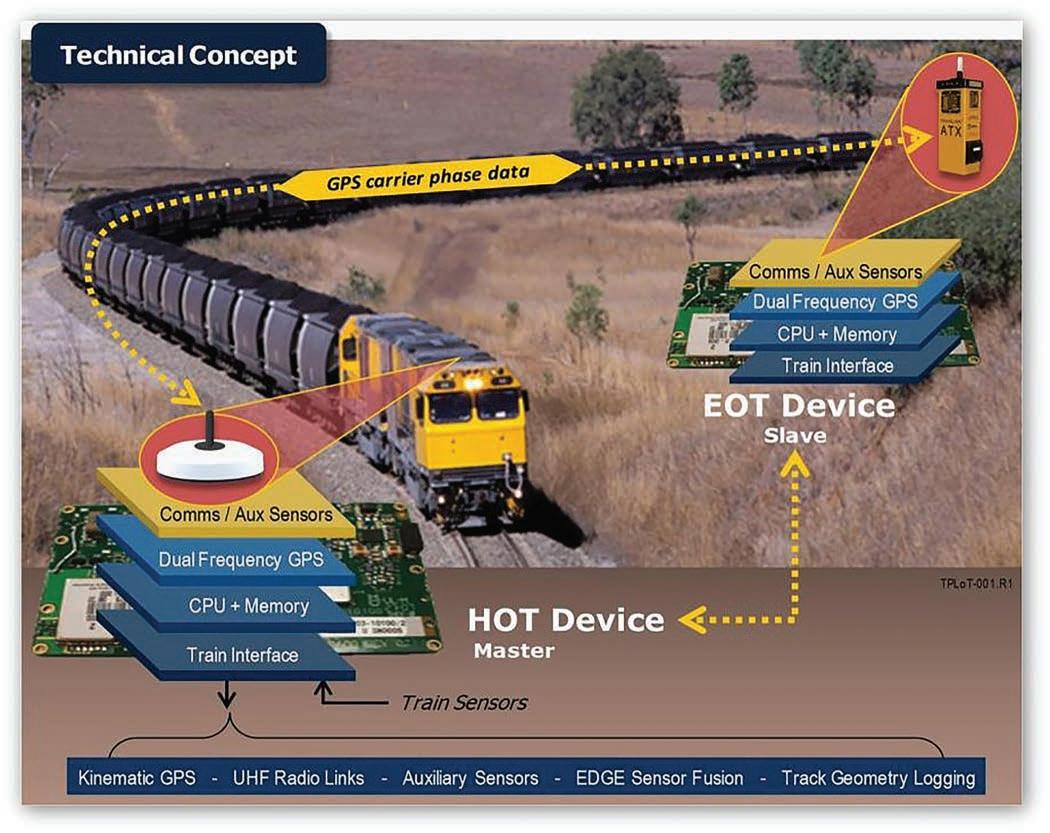 BY WILLIAM C. VANTUO N O, EDITOR-I N -CHI EF
BY WILLIAM C. VANTUO N O, EDITOR-I N -CHI EF
Next-Generation” or its abbreviation, “next-gen,” is a popular expression that has been used (some say abused) to name things from television shows (Star Trek, The Next Generation) to conferences (Railway Age’s Next-Generation Freight Rail and NextGeneration Train Control, our joint effort with Parsons since 1995). For train control, it has become a kind of blanket definition for CBTC (communications-based train control), PTC (Positive Train Control), and various iterations of both that have evolved
into an addling acronym alphabet soup: ATC, ACSES, ASES, ETMS, ERTMS, ETC, ITCS, I-ETMS, VTC, etc., etc.
As far as the global railway industry and its continuously contracting cadre of suppli ers and consultants are concerned, they have taken Capt. Jean-Luc Picard’s command for “warp speed” from the bridges of the Enter prise D and E starships— engage! —to heart, though at times the warp core has sputtered out, leaving only impulse power available.
But “failure is not an option” (Apollo 13), and “fail-safe” or “vital” is usually an imperative. Thus, there are now a burgeoning
number of greenfield and brownfield next-gen train control programs for transit and main line freight and passenger operations, with AI (artificial intelligence) and other “space age” technologies added to spice things up a bit. There’s enough going on to support the annual Railway Age /Parsons get-together— enough to fill this entire October issue. But we only have two pages. If you want a much bigger picture with many more details, make your way to Philadelphia this month to attend the 2022 iteration of the aforementioned conference. Details at https://www.railway age.com/nextgen/. Make it so!
32 Railway Age // October 2022 railwayage.com TECHNOLOGY FOCUS – C&S
Federal Railroad Administration
“
MTA LEADS THE WAY
Roughly 30 years after a then-younger Railway Age editor whose initials are WCV wrote his first piece on MTA New York City Transit’s then-new Advanced Technology Signals program, NYCT—with a brief stall during a 2007-08 financial crisis—is still ahead of the curve in brownfield (sounds more like a lawn that hasn’t been watered during a drought than a major technology upgrade to a “legacy” system) projects. It’s fair to say that, with three CBTC-equipped lines in service—Canarsie (L), Flushing (7), QBL West (E, F, M, R)—two in prog ress—Culver (F), Eighth Avenue (A, C, E)— another recently awarded—QBL East (E, F, M, R)—and three in procurement—Cross town (G), Fulton (A, C), Sixth Avenue (B, D, F)—NYCT remains the first major network, globally, successfully transitioning to CBTC. The workload and required financial resources for so many parallel projects are, at the very least, daunting. But they’re doable.
The MTA can thank Tom Prendergast (Railway Age 2017 Railroader of the Year) for resurrecting its CBTC program and accelerat ing it. With his rail career rooted in safety, he had always championed the technology, partic ularly during his tenures as NYCT President (2009-13) and MTA Chairman (2013-17). After Prendergast retired from the MTA to go to STV and then AECOM (where he is EVP and Amer icas Transit Market Leader), the “British Inva sion” (Andy Byford and Pete Tomlin) took up the CBTC flag, opening the door to new tech nologies like UWB (ultra wideband) through the “Genius Challenge” program. This, and initiatives like the Transit Tech Lab, are where companies such as Piper Networks, 4AI Systems, Luminar, Ouster and Lux Modus can demonstrate their capabilities alongside those of long-time players Alstom, Siemens, Thales and Hitachi. Relative newcomers to the MTA like Mitsubishi Electric and E-J Electric Transit Division have joined its growing list of suppli ers. At the NGTC conference, the MTA plans to announce a change in technical approach to CBTC procurements.
Piper Networks’ UWB-based position and speed technology system recently received safety certification from TÜV SÜD. It was the first to achieve CENELEC Safety Integrity Level 4 (SIL-4) certification to the following standards:
• Functional Safety Certification: EN 50126, 50128, 50129 and 50159.
• EMI/EMC Certification: EN 50121-1, 50121-3 and 50121-4.
• Environmental Certification: EN 50155 and IEC 60068-2.
Piper, TÜV Rheinland, Frauscher, ClearVu Lighting, Thales and 4AI will be giving sponsored NGTC conference proceedings on some of their latest developments. Again, ya gotta be there!
FRA PTL
Here’s another acronym to add to the train control dictionary: PTL (Positive Train Location), a Federal Railroad Adminis tration initiative. “The ability to precisely locate and track train movement on the rail network is the cornerstone of modern train control systems,” says Sam Alibrahim, FRA Chief, Train Control and Communication Research Division. “The Interoperable Elec tronic Train Management System (I-ETMS) and PTC systems currently used by Class I railroads, operational on approximately 54,000 route-miles, rely on GPS to identify the location of the lead locomotive, crewentered track information and switch posi tion. The location of the rear of the train is then derived from the location of the lead locomotive using train length, typically provided by the railroad’s management information systems (MIS) and confirmed or updated by the locomotive engineer.
“The relative inaccuracy of GPS and the manual entry of track information at train initialization often results in operational deficiencies. For these reasons, FRA’s Office of Research, Development, and Technology (RD&T) and the railroads cooperatively launched research into innovative methods to precisely locate and track train move ments. This research resulted in what is now known as the PTL system, which is being commercialized by the railroad industry and deployed by Class I railroads.”
PTL research was conducted in multiple phases from 2011 through 2017; in Phase I, FRA RD&T and the railroads set forth the following performance requirements:
PTL (illustration, opposite) is required to accurately determine locomotive and end-of-train position and train location at initialization and during operation. Key performance requirements include estimat ing the navigation state for Head-of-Train (HOT) and End-of-Train (EOT) units, support HOT/EOT communications for
trains up to five miles in length, track HOT/ EOT navigation state in all environments (with and without GPS), and support navi gation accuracy requirements.
Alibrahim will be presenting on how FRA is supporting next-gen train operations at our conference. Again, ya gotta be there!
‘O PERATIONS ARE PARAM OUNT’
The PTC mandate was a very heavy lift— technical, operational and financial—for railroads. Herzog, through its HTI (Herzog Technologies Inc.) division, is among the companies engaged in easing the burden.
“Many railroads still face significant chal lenges with the costs and complexity asso ciated with PTC,” HTI tells Railway Age. As such, it has developed “a full suite of PTC-related services and software solu tions” for freight and commuter railroads called HMOS (Hosting, Maintenance and Operational Support), which “integrates qualified personnel, specialized systems, PTC software and highly available archi tecture and centralizes it into a simplified service offering. The service is supported by a 24/7 systems operations support center staffed with knowledgeable and expe rienced PTC professionals that provide dedicated, versatile and operations-centric solutions. The HMOS Center is fully interoperable, reliable and secure. Utiliz ing advanced phone systems, a robust ticket management solution and proactive moni toring software tools, the HMOS Center is designed for rapid and organized responses to PTC issues.”
HMOS currently supports 215-plus daily, 6,500-plus monthly and 78,000-plus annual PTC trains “with skill sets ranging from Support Center Representative to Commu nications Technician to Systems Adminis trator, to provide tiered levels of support. The HMOS Center is designed for rapid and organized responses to everything from CAD, PTC and Voice & RF Systems trouble shooting to environmental dangers or even unruly passengers. We aim to recognize issues before they impact operations. The HMOS Center is designed with the under standing that operations, not various PTC technologies, is paramount. These solutions can mean the difference between seconds, minutes or hours of operational impact.”
Unruly passengers? Would that be “Passenger Tantrum Control”?
October 2022 // Railway Age 33 railwayage.com
C&S
TECHNOLOGY FOCUS –
ROLLING INTO ORLANDO
 BY DAVID C. LESTER, MANAGING EDITOR, RT&S
BY DAVID C. LESTER, MANAGING EDITOR, RT&S



Anew and different world awaits passengers about to enter Brightline’s Miami Central station. High ceil ings, tall windows and clean, bright lighting surround you, and uniformed Brightline personnel are every where, ready to take care of any needs or issues. There are two counters at one end of the lobby where you can drop off your baggage. Above are three signs, the center one indicating bag drop, while the two on each side reinforce a big part of the Bright line message: Guest Services. Color tastefully
abounds with bright yellow and green trim and a series of lighted kiosks and screens delivering messages and videos about Bright line and community events. And, at this point, you’re still on the first floor, and you’ve walked no more than 50 feet.
You’re filled with anticipation as you ride up one of several escalators to the train plat form. If you’ve never ridden a train before, you’ll be overwhelmed by the sleek, modern train that looks a little like something you’ve seen in futuristic books. Experienced train riders, even those who have ridden trains in other parts of the world, will beam with
34 Railway Age // October 2022 railwayage.com David
C. Lester brightline
Brightline realizes its dream to connect Miami and Orlando while continuing to look ahead.
Brightline trains have a Siemens Charger locomotive on each end of a four-car train and can expand up to 10 cars as ridership demand warrants.
fare. Moreover, each station’s premium lounge offers similar delights, with ample seating in a pleasant environment. While the smart car service has slightly narrower 19-inch seats and beverages and snacks come with a nominal charge, this class of service is by no means slouchy. The high seat backs and convenient outlets provide an experience very close to the premium cars. Strong, easy-to-connect wifi service is available in the station and onboard the trains. No password is required, so you can connect and get to work. The ride is smooth and steady at all speeds, with no jostling around or water pitchers hitting the floor because of bad track. Brightline trains, stations and lounges are all pet-friendly, too. And, to top it off, the large picture windows by each seat allow you to watch the world flashing by at up to 79 mph.
PANDEMIC B LUES?


satisfaction as they think, “Man, they’ve really got something here!”

Boarding the train is much like entering a brand-new commercial aircraft. Whether riding in a premium or smart car, it’s easy to see the preparations for your comfort and convenience are complete. Large, comfort able, sewn leather chairs, easily accessible electrical outlets and USB ports, and the seat backs are high enough to afford a nice bit of privacy.
The 21-inch seats in the premium service cars provide plenty of room to move around, and snacks and beverages are part of your
Brightline began service in 2018 between Miami and West Palm Beach, with an inter mediate stop in Fort Lauderdale. While the world suffered through the pandemic, which shut down Brightline for 19 months beginning March 2020, some layoffs occurred. However, this “downtime” also allowed Brightline planners to review every aspect of their service. One item coming out of this review is the idea for private auto and shuttle first-mile – last-mile service for passengers within a five-mile radius of a station, called “Brightline plus.” This service helps drive Brightline’s advertis ing slogan, “Go Car-Free. Carefree.” If you live close enough to the station, the railroad can handle your transportation from the moment you walk out of your door to the minute you step back in upon return. The private auto fleet consists of all-electric Tesla cars for individual riders, while the shuttle service is composed of traditional multi-passenger vans.

In addition to developing new ideas, the Brightline team continued construction on the line to Orlando during the pandemic. The railroad resumed operation in Novem ber 2021 and has provided hourly service for nearly a year, with 16 round trips per day between Miami and West Palm. And any concerns about interest in the railroad dropping off due to the pandemic were thrown to the wind when ridership came roaring back upon reopening.
brightline
Indeed, Brightline president Patrick Goddard told Railway Age that “year-todate, our ridership and revenue is at about 150% to 170% above what it was before COVID hit. We look at that as a posi tive indicator, and considering that other transit agencies are still at around 80% of their pre-pandemic ridership, we feel like we’re headed in the right direction. Rider ship keeps growing, and our marketing is increasingly effective. There is a lot of momentum building around the two addi tional stations we will open in south Florida later this year (Boca and Aventura). We’ll finish the build into Orlando next year.” Boca is between Fort Lauderdale and West Palm. Aventura lies between Miami and Fort Lauderdale. Goddard adds, “this will give us six pick-up and drop-off points in south Florida, where the population is six million. We felt it made sense to create more accessibility to residents with the new stations. This will have a strong short-term impact on our operation, especially when we begin service to Orlando.”
SUCCEEDING LONG TERM
While evaluating the opening and initial performance of the fledgling railroad, living through the deadliest pandemic in United States history, and the tremendous rebound during the past year, one cannot help but marvel at the success of Brightline. This is particularly true when considering the choppy history of rail passenger service in the U.S. A question that keeps coming to mind is – can Brightline be successful longterm? Can they revolutionize passenger service in the United States? Many answer “yes” to both questions.
Much of the story around America’s rail passenger history is not pleasant. After revolutionizing civilization in the 1830s by providing a mechanical and success ful means of moving freight and passen gers, railroads opened the country to most Americans over the ensuing decades. While passenger service began to tail off slightly in the first half of the twentieth century, World War II stretched the system beyond its capacity. Afterward, although facing stiff competition from highways and airways, the railroads made a valiant effort to draw passengers to the rails with powerful diesel and electric locomotives, streamlined equipment and exemplary service. However,
October 2022 // Railway Age 35 railwayage.com
brightline
all of this was for naught as personal auto mobiles and jet aircraft sounded the death knell for passenger trains.
Then, when railroads faced the possi bility of nationalization due in part to a heavy burden of required passenger and commuter train operation, commuter and transit services became the responsibility of state and municipal governments, and Amtrak was formed in 1971. The passenger railroads came wheezing into the station to be “rescued” by the National Railroad Passenger Corporation, but this rescue was a lot of show and very little bite. To say that Amtrak’s history, even considering the recent flood of money available to it from federal infrastructure programs, has been nothing but tortured is an understatement.
So, it’s against this backdrop that the founders of Brightline had the moxie to attempt successful rail passenger service in America. Although not the be-all and end-all service that Amtrak tries to be, Brightline’s success builds on several factors. First, it’s the vision of Wes Edens, the co-founder of Fortress Investment Group, who founded Brightline in 2018 after being inspired by Henry Flagler in Les Standiford’s Last Train to Paradise: Henry Flagler and the Spectacu lar Rise and Fall of the Railroad that Crossed an Ocean. Goddard paraphrases Edens by saying, “Why the hell can’t we have this [high-speed rail]? Why are we 50 years behind the rest of the world? Can it be done privately and can it make money?” Edens believed the answer was “yes.” Goddard added that the Flagler book is now required reading for Brightline employees. Edens then recruited Mike Reininger, who is known as a visionary developer of experiential busi nesses, to lead the effort. Reininger had a background with the Walt Disney Company and other developments where he demon strated skill at taking visions and developing them into physical assets.
Next, Gene Skoropowski, who has spent most of his life in the passenger rail busi ness, including a stint at the Capitol Corri dor in California, was brought in to help design rail operations. Skoropowski, a veteran of previous work on high-speed rail concepts in Florida, knew the players and the market. In addition to helping design the rail operation, Skoropowski served as an ambassador for Brightline in the early years, making speeches and presentations
throughout the country to spread the news.
Reininger recruited Patrick Goddard because of his background in the hospital ity industry. Goddard’s task was to look at the railroad experience through the lens of someone with a hotel background. He focused on architecture and interior design and questions such as Does the lobby smell good? Is the coffee hot? Are the people nice? Does the technology work? And all the things that take the commodity of transportation and turn it into an experience. Goddard has built a team that focuses on this aspect of product development. They’re thinking every day about things like the food quality, the music playlist in the lobby, uniforms, standard operating procedures, how they greet people, how they solve problems, how their app works, how parking works, evaluat ing the performance of Brightline plus, and making the entirety of Brightline a better product. Goddard adds that he “stands on the shoulders of giants” and “it’s now time for the Brightline team to deliver on the commitment and vision of the founders.”
Another important factor in determining why Brightline believes it can be successful against the dismal backdrop of American rail passenger service is that the railroad serves a different market than most tradi tional U.S. trains. Goddard points out, “While Amtrak does have some perfor mance goals it must meet, its design does not include profit.” The only U.S. service Brightline can compare to is the Acela in the Northeast Corridor, which does make an above-the-rail profit. Beyond that, Bright line’s counterparts are European and Asian services, such as Italo, Eurostar, Shinkan sen and several other systems worldwide. These are highly profitable above the rail, with margins between 50% and 70%. Those services are comparable to what Brightline is doing, as opposed to Amtrak and local commuter and transit services.
Goddard adds, “The base of our model is city pair corridors that are too long to drive and too short to fly. These city pairs are densely populated and connect with very congested highway infrastructure. Plus, when you look at comparable systems around the world, they seek to capture the addressable travel market, which is around 15%, and in some cases, between 30% and 40%. In our case, in the Florida market, we only need about 5% of the addressable travel
market to be profitable. In the Los Ange les-Las Vegas market, we need to capture around 15%.” The difference between the addressable travel market in south Florida and L.A.-Vegas is that there are multiple ways to move between city pairs in Florida, while there is essentially only one way to get from L.A. to Vegas along I-15.
From a fare perspective, Brightline only needs to charge about a third of what Acela costs. “So, these things give us the highest degree of confidence in our path to profit ability,” said Goddard “We’re operating today only about 20% of what our system will be capable of in terms of capacity and about one-fifth of our fare potential. Our opera tion thus far has been a proof-of-concept, demonstrating that people will get out of their cars and look at the train as a viable mode of transportation. We’re warming up the Florida market as we prepare to roll into Orlando. At the same time, Orlando is a less populated market; it is, however, much bigger in terms of a domestic and international tourist attraction, making it more significant as a demand generator.”
Brightline has about 85% of awareness in the Florida market—i.e., about 85% of the people it wants to know about Brightline do know about it, about half of those people have tried the train, and about half of those people are riding the train frequently.
REAL ESTATE—TO A POINT
Brightline is also making significant real estate investments, but the company says that real estate investments and railroad investments follow completely differ ent “investment theses.” Goddard points out that the two investment activities are complementary in that having rail stations surrounded by residential, office and retail operations come with a great deal of synergy between the surrounding community and the rail station. “In Miami, we invested about $1 billion in 1.5 million square feet of real estate and essentially created a small city around the station which is a destina tion,” he said. “This area on the western side of downtown was in neglect before we came in. There was no development within five blocks of this project. Since our devel opment, there has been an additional $3 billion of real estate investment in the fiveblock area around our station.”
Moreover, Brightline’s presence generates
36 Railway Age // October 2022 railwayage.com
additional transit development around the station, which benefits the entire area. The company sought to incorporate other transit services as part of the station, which also serves Metro Mover, MetroRail and TriRail. These lines serve as feeder systems to the Brightline intercity service and collectively serve about 40 million passengers annually.
This model is adopted wherever Bright line has announced plans for a station. When a new station announcement is released, local transit agencies ask themselves how they can connect to the station. Real estate developers also react because of the success in the area around MiamiCentral.
OTHER POTENTIAL CITY PAIRS
Brightline is working on a line to connect its eastern Florida/Orlando line to Tampa. While the Orlando line is about ready to open, work on the Tampa line is just start ing. Indeed, the railroad is currently deter mining the best route between the two cities and working on issues of eminent domain, utilities and other things that the company must resolve before the first spade of earth can turn on the new line.
Vanessa Alfonso, a spokesperson for Brightline, told Railway Age that “this is a generational moment for transporta tion and train travel. Frequent departures, 200-300-mile markets, and higher speed. We believe that Brightline has proven that short legs for high-speed rail are needed, as evidenced by the quick growth we’ve had.” She added that 12-15 other city pairs in the country offer opportunities for Brightline.
In addition to the Miami-Orlando-Tampa and Los Angeles-Las Vegas lines, Brightline says that other potential routes include Atlanta-Charlotte, Washington-New YorkBoston, St. Louis-Chicago, a Texas triangle of Dallas-Austin-San Antonio-Houston and Portland-Seattle-Vancouver.
NEXT STOP: ORLANDO!
While Brightline has been successful so far, its service, impact on Florida rail and influ ence on the redevelopment of passenger rail in the U.S. will likely be tremendous. The growth of ridership, revenue and real estate adjacent to stations will be interesting to watch. Moreover, the Orlando station is at Terminal C of the Orlando International Airport (MCO), the second-busiest airport in Florida and the 14th-busiest in the U.S.
Brightline service to and from the airport will likely further boost ridership among both domestic and international travelers.
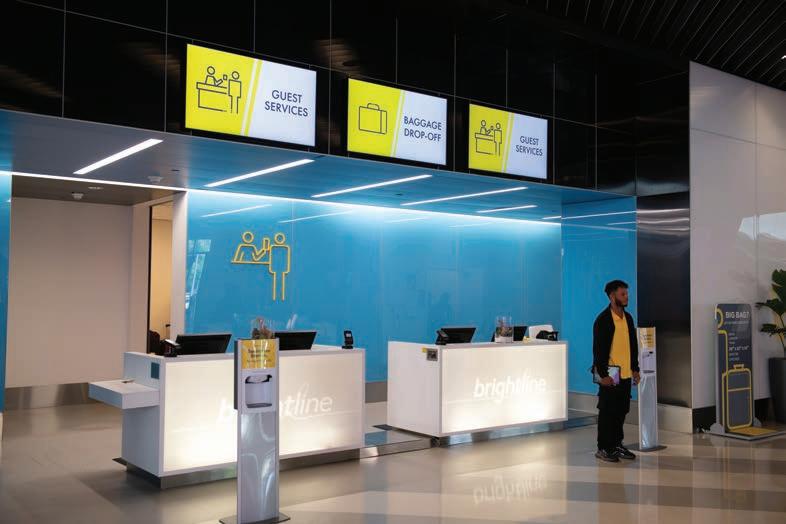
Goddard said that the line to Orlando is about 85% complete, and it’s undergoing high-speed testing now. He also pointed out that, from the Federal Railroad Administra tion’s perspective, upgrading existing tracks for higher-speed service is one thing. Yet, it’s different to build them from scratch, as Brightline is now doing.
Most of the external construction of the Brightline station at the airport is complete, while the build of the interior of the station is progressing rapidly. However, Goddard would not commit to an opening date at this point. Given work still left to do and completion of line testing, Brightline’s pres ident would only commit to “next year.” Many observers believe the opening will likely be in the first quarter.
In addition to the line and station facili ties, Brightline’s Orlando footprint includes a locomotive repair shop, which it calls a “vehicle maintenance facility,” that is 135,805 square feet, a 9,542-square-foot train washing facility, and 7.75 miles of maintenance and storage track, all on a 62-acre site. The locomotive shop features drop pits and a 30-ton overhead crane, and the facility can support heavy repair on both locomotives and cars.
Brightline trains have a Siemens Charger locomotive on each end of a four-car train,
but these trains can expand up to 10 cars as ridership demand warrants. This is not a push-pull service, though. The two loco motives on the train ensure plenty of power to maintain speed and serve as a backup in case one engine fails. In addition, this configuration eliminates the need for the train to turn around at each termination point, saving millions in operational costs.
REVO LUTIO NARY?
New passenger rail service built from the ground up has not appeared in the U.S. for more than 100 years. Transportation plan ners and rail advocates have always debated the requirements for rail passenger service to be successful. Traditional refrains include frequent departure times, dense popula tion centers, short-to-medium distances, clean stations and trains, and quality service. Brightline appears to have all these things in its business model. Moreover, the company’s comprehensive approach to identifying “qual ifying” city pairs and exceptional attention to the synergy between real estate development and station location brings a new level of thinking to rail development. Urban plan ning is a discipline of its own, and Brightline is incorporating some of the best thinking in this arena to improve its chances for success.
With everything we’ve seen so far, we believe Brightline has an excellent chance to truly revolutionize the world of U.S. passenger rail.
October 2022 // Railway Age 37 railwayage.com
brightline
David C. Lester
CONDITION TRENDING AND PREDICTIVE ANALY TICS:
IT’S NOT EXTRAPOLAT I O N
By Gary T.
elcome to “Timeout for Tech.” Each month, we examine a technology topic that professionals in the railway industry have asked to learn more about. This month we focus on using data to support condition trending of engi neered systems.
The right data, collected and processed
FIGURE 1. Beginning in the late 1940s, cars with tail fins became a global trend, and each model year in the following decade seemed to produce more prominent fins. Tail fins maxed out with the 1959 Cadillac, whose pointy protuberances were 42 inches above the ground! Pictured is an Eldorado Biarritz convertible, of which only 1,320 examples were built, selling for $7,400 ($75,000 in 2022 dollars). Today, they’re worth about $400,000. (Courtesy Hyman Ltd. Classic Cars)


 P.E., Vice President, Fry Technical Services, Inc.
P.E., Vice President, Fry Technical Services, Inc.
Win the right ways, can give critical insight to an engineered system’s fitness for service. In fact, with an archive of suitable data, we can assess the system at various points in time: past, present, and most desirably, future. Reliable knowledge of the present and future fitness of a system can both enhance its safety and reduce its cost to owners. This is a very attractive double-win scenario.
We begin by pointing out that there is no dearth of data for the engineered systems on railways. Railroad rail lasts 15 years or more; ties can last 10-20 years or more depending on materials and environmen tal conditions; bridges last 100 years or more; and cars and locomotives 30 years or more. And all these assets are inspected and serviced on regular schedules through out their useful lifetimes: annually, weekly,
38 Railway Age // October 2022 railwayage.com
TIMEOUT
FOR TECH
Historical datasets are important to consider, but it is much more than a simple process.
Fry, Ph.D.,
even daily. With increasing frequency and volume, much of today’s data is generated, transmitted, and archived in digital forms.
In short, there is plenty of data readily available! So, for purposes of condition trending and prediction, how do we ensure we have the right data streams? And how do we ensure we are processing them in the right ways? It turns out that, like the engineered systems themselves, the right data streams and processing methods exist by careful design and in close collabora tion with experts knowledgeable in the engineering details of the systems. It is not always easy to reliably achieve the “doublewin” safety-cost scenarios we seek. The design and implementation process is often complex and resource intensive involving multidisciplinary teams of domain experts and data science experts. Sometimes budget and resource constraints result in less than comprehensive efforts.
Let’s begin with a fun example of what could happen when an overly simplified approach is used to make a data-driven future prediction. Starting from the late 1940s, tail fins on American cars became an increasingly popular aesthetic. The fins began as subtle, rounded geometric forms that peeked over the sides of the trunk lid by two or three inches. By the end of the 1950s, some car models sported promi nent, sharp-edged fins of 12 inches or more. Figure 1 is a photograph of a 1959 Cadillac Eldorado Biarritz convertible. As
many of us know, ’59 Cadillacs had very prominent tail fins!
Here we seem to have the basic ingre dients for a data-driven predictive tool. Tail fin height and shape are unargu ably objective data sets, and we have them over a period of several years. Let’s take a simple path and extrapolate linearly using the data from the years between 1950 and 1959. Doing so we can predict that many production car models in 2023 will have razor-sharp tail fins that are roughly six feet tall. How’d we do with our prediction? It suffices to say that car body evolution is not well approximated by a linear function with respect to time—at least over the long term.
I have used this example many times in different contexts, and it never fails to bring smiles. Unfortunately, however, there are numerous unsmiling real-world examples I have encountered over the years that are directly analogous to the six-foot tail fin prediction. And they sometimes came complete with severe and lasting economic and reputational repercussions for the teams and organizations involved.
Let’s go through a different example that illustrates a logic process for developing a predictive model. We will see that histori cal data sets are important to consider, but it is much more than a simple process of extrapolation. We must make sure the data sets are relevant and that we include all of the essential influencing parameters.
Imagine that I have a flight to catch.
TIMEOUT FOR TECH
When do I need to leave the office so that I arrive at the boarding gate on time? This is a problem many of us have encountered and usually solve successfully. But how often have we considered this to be a basic exercise in predictive analytics? Suppose we create a model that is an ordered list of the trip segments that largely deter mine the time of our trip to the gate (the logic of the model) and an estimate for the duration of each segment. For example, Table 1 (above) contains a list of those trip segments and the parameters that might influence the duration of each segment.
With the list assembled, all that remains is to create estimates for the segment dura tions. I rely largely on my historical expe rience and current information from my phone apps about traffic, weather condi tions, and expected wait times at the airport. I usually add 15 to 30 minutes to the estimate as a buffer.

The process of modeling the evolving condition of engineered systems as they experience wear and tear requires a logic similar to the airport travel time example. We need to identify the significant param eters that influence the degradation of the system and estimate the amount of influence each parameter contributes to the degradation. For example, consider designing a predictive model for rail wear caused by train loading.
In general, we can’t simply measure rail wear at a particular location for several
October 2022 // Railway Age 39 railwayage.com
TIMEOUT FOR TECH
years and apply that historical data to predict future rail wear at a different loca tion. We can’t even measure rail wear at several locations for several years and apply a statistical summary of the data as a representative predictive model for a new location. This is because each loca tion of track, such as seen in Figure 2, has a specific set of parameters that influence rail wear: for example, car types, axle loads, wheel profiles, train frequency, train speed, track curvature, superelevation, track type, track condition, rail profile, rail metallurgy, rail lubrication, etc. An effective predictive model for rail wear will include all the influencing parameters and their relative contributions with appro priate logic and mathematical representa tions. When assessing a particular track location, one simply provides the param eters of that location as input to the model and the model will generate estimates of rail wear associated with those parameters.

The takeaways are these. Condition trending for engineered systems and future condition prediction requires more than historical data. All the significant parameters that influence condition must be identified and modeled with appropri ate logic. The predictive modeling process often benefits from multidisciplinary teams of domain experts and data scien tists working together. It’s not simply a process of extrapolating history to predict the future.

Dr. Fry is the Vice President of Fry Tech nical Services, Inc. (https://www.frytechser vices.com/). He has 30 years of experience in research and consulting on the fatigue and fracture behavior of structural metals and weldments. His research results have been incorporated into international codes of practice used in the design of structural components and systems, including struc tural welds, railway and highway bridges, and high-rise commercial buildings in seismic
risk zones. He has extensive experience performing in situ testing of railway bridges under live loading of trains, including highspeed passenger trains and heavy-axle-load freight trains. His research, publications and consulting have advanced the state of the art in structural health monitoring and struc tural impairment detection.
40 Railway Age // October 2022 railwayage.com
FIGURE 2. Rail wear depends on several parameters that are determined by tonnage and track construction. (Courtesy Gary T. Fry)
JOE HINRICHS CSX
HIGH PROFILE: As “part of a planned succession pro cess,” former Ford Motor Company executive Joseph R. Hinrichs last month became CSX President and CEO, succeeding James M. Foote, who retired from the top leadership roles, as well as from the Board, but will re main with the Class I railroad through March 31, 2023, as an advisor “to facilitate a seamless leadership transi tion.” Hinrichs served previously as President of Ford’s automotive business, where he led the company’s $160 billion global automotive opera tions, after having held the positions of President of Global Operations, President of the Americas, and President of Asia Pacific and Africa. Hinrichs has also served in executive roles in global manufacturing, materials planning and logistics.
Hinrichs also serves in advisory and Board positions of various companies, including Ex ide Technologies, Luminar Technologies, microDrive and First Move Capital. He previ ously served as a Senior Advisor at Boyden California, an operating advisor at Assembly Ventures, as well as a Director at Ascend Wellness Holdings; GPR, Inc.; Rivian Automotive, Inc.; and Ford Motor Credit Company. He was Chairman of the National Minority Sup plier Development Council from 2016-19 and also served on the boards of CEO Climate Dialogue, Climate Leadership Council and the U.S.-China Business Council.
Hinrichs holds a Bachelor of Electrical Engineering magna cum laude from the Uni versity of Dayton and an MBA from the Harvard Business School. He also holds an Honorary Doctor of Human Letters from Tiffin University and an Honorary Doctor of Science and Business Administration from Cleary University.
“Joe’s great strength is operational excellence,” Foote said. “He enabled Ford to execute world-class manufacturing on a global scale, including prioritizing exceptional customer service. In addition to leading complex businesses over his 30-year career, he has proven that he understands how to prioritize safety and efficiency in an industry with dynamics that are similar to those we are navigating today in rail. On top of that, Joe truly believes that CSX’s people are critical to its success, and he is focused on forging strong relation ships across the organization. Given his excellent track record around operational excel lence and employee engagement, I am confident Joe is the right person to lead CSX.”
“I am honored to lead a company as strong and storied as CSX,” Hinrichs said. “My focus on day one will be to continue to execute on the strategy the team has identified: leveraging CSX’s proven operating model as a leader in the railroad industry, to drive growth through innovation, harness transformative technology and build a one-team workforce through an engaging and inclusive culture. I look forward to working closely with the Board, leadership team, labor and government leaders, and the people of CSX to achieve operational excellence that meets industry demand and delivers for our cus tomers and shareholders.”
Denton County Transportation Authority, Texas, last month appointed Paul Cristina as the agency’s new President and CEO following a near sixmonth nationwide search led by Gregg Moser of Krauthamer & Associates, LLC, a “recognized expert in placement of executive transit leaders across the country.” DCTA, shortlisted and interviewed five candidates, three of whom were extensively interviewed in-person following a tour of the entire

system. Ultimately, the agency selected Cris tina “based on his demonstrated aptitude in leading the agency as Interim CEO since March 15, 2022.” Cristina joined DCTA in December 2021 as Deputy CEO. Prior to that, he served as Director of Public Private Partnerships at BNSF, where he led engage ment with public agencies across the rail road’s 23,500-mile rail network. Before his tenure at BNSF, Cristina served as a civil engineer officer in the U.S. Air Force, holding
positions of increasing responsibility at Tyndall Air Force Base, Grand Forks Air Force Base and overseas in support of Oper ation IRAQI FREEDOM. After leaving the Air Force, Cristina worked as a civil engineer and planning consultant in Florida. He earned his bachelor’s degree in Civil Engi neering from the U.S. Air Force Academy and an MBA from Florida State University. He is a registered Professional Engineer in the State of Texas and resides in Flower Mound with his wife and three children.
James J. Florio, the former Governor of New Jersey and eight-term congressman who was the principal author of the 1980 Staggers Rail Act that partially deregulated the industry, died Sept. 25. He was 85. Florio had been part of New Jersey politics since 1969, when he won a seat in the New Jersey State Assembly. He spent 15 years (19751990) as a congressman from South Jersey, and was governor from 1990 to 1994. Born in Brooklyn, Florio was an amateur boxer and U.S. Navy veteran who came to New Jersey to attend college and law school. He got started in politics as assistant Camden City Solicitor. In Congress, he served on the Transportation, Energy and Commerce committees. He was principal author of the 1980 Staggers Rail Act while chairman of the House Transportation Subcommittee. “At a time when polemics is delivering knockout blows to civil discourse and col laboration, a 78-year-old former amateur boxer—still punching above his weight— has advice on peaceful dispute resolution that lawmakers, regulators, rail executives and labor leaders would do well to read, mark and inwardly digest,” Railway Age Capitol Hill Contributing Editor Frank N. Wilner wrote in 2016. “Well before alterna tive dispute resolution earned wide accep tance, Florio stapled himself into railroad history by focusing disparate parties on a shared goal of preserving railroads as pri vate-sector, taxpaying entities able to meet shipper demands, improve productivity and provide solid middle-class wages and benefits. Collaborating with Illinois House Republican Ed Madigan, Florio persuaded squabbling shipper, labor and carrier parties to embrace a framework for partial economic deregulation that salvaged a then-overregulated and underfinanced rail industry from a least desired nationaliza tion alternative.”
October 2022 // Railway Age 41 railwayage.com PEOPLE
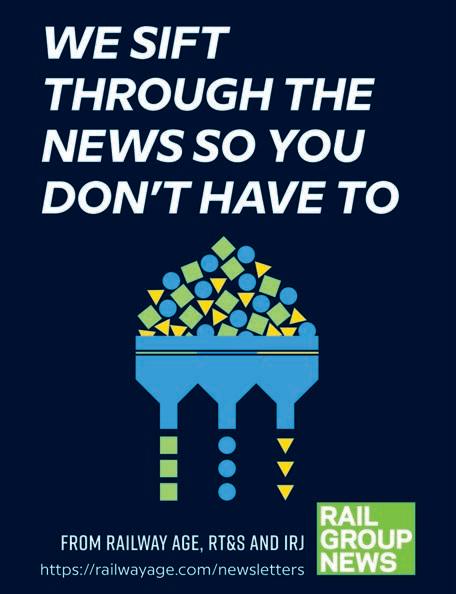
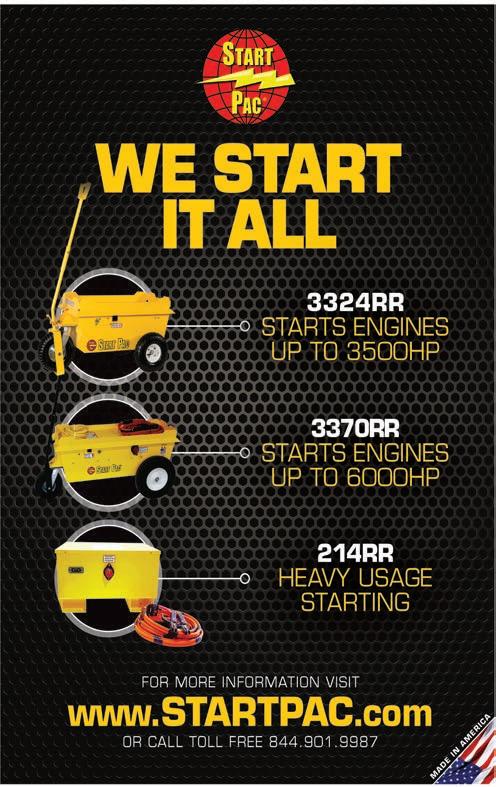
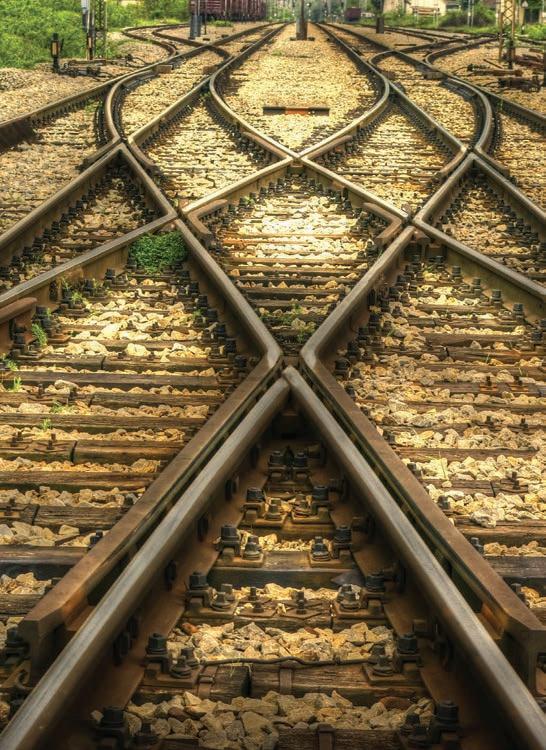





42 Railway Age // October 2022 railwayage.com RECRUITMENT EQUIPMENT SALE/LEASING Edna A Rice Executive Recruiters SPECIALISTS IN RAIL AND TRANSPORTATION RECRUITING SINCE 1988 713-667-0406 www.ednarice.com LEARN MORE
212-461-5781 816-245-9415 513-419-6200 678-904-6300 315-786-5431 800-221-CLIP 256-505-6402 800-983-0044 757-903-4606 402-346-4300 262-939-8129 800-631-4420 312-347-5705

October 2022 // Railway Age 43 railwayage.com Ad Index The Advertisers Index is an editorial feature maintained for the convenience of readers. It is not part of the advertiser contract and Railway Age assumes no responsibility for the correctness. COMPANY PHONE # URL/EMAIL ADDRESS PAGE #
James.Spencer@cit.com tjfrancis@cometind.com txs@djj.com Natalie.cornell@hatch.com infinitygafg.com Janice.Pfeil@nyab.com info@progressrail.com sales@radtorque.com jhusband@railsoultionsinc.com bbrundige@sb-reb.com
trinityrail.com nilsson@utlx.com 11 5 13 31 18 30 26 17 C2 C4 16 C3 19 3 15 CIT COMET INDUSTRIES DAVID J JOSEPH COMPANY HATCH LTK INFINITY TRANSPORTATION NEW YORK AIR BRAKE PANDROL USA LP PNW RAILCARS INC PROGRESS RAIL A CATERPILLAR CO RAD TORQUE RAIL SOLUTIONS INC RAILWAY EDUCATIONAL BUREAU RELAM INC TRINITY RAIL UNION CAR TANK COMPANY/UTLX STAY IN GEAR WITH RAIL GROUP NEWS RAIL GROUP NEWS brings you a daily round-up of news stories from Railway Age, RT&S, and IRJ. This email newsletter offers North American and global news and analysis of the freight and passenger markets. From developments in rail technology, operations, and strategic planning to legislative issues and engineering news, we’ve got you covered. ROUND-UP of NEWS R AILWA RAIL GROUP NEWS From Railway Age, RT&S and IRJ https://railwayage.com/newsletters RA_RailGroupNews_Third_InGear_2022.indd 1 1/26/22 1:25 PM
cnielsen@relaminc.com
Perspective: ASLRRA
Short Lines, Backbone of the Ag Supply Chain
Pe ople take freight rail service for granted, until they don’t. Then they panic and rightly so. This is not a knock on the people, but an indication of how impor tant freight rail service is, even though it normally travels under the radar. But that radar sure lit up brightly when it looked like a railroad strike would close down freight service across the country.
As the Association of American Rail roads (AAR) has reported, the loss of economic output would be at least $2 billion per day. In the first half of 2022, approximately 7,000 trains hauling more than 75,000 carloads and intermo dal containers and truck trailers began their rail journey each day. Handling this freight would require about 467,000 additional long-haul trucks per day. America doesn’t have the trucks, the drivers, the highway capacity or the highway maintenance budget to meet that demand. As President Joe Biden said in announcing the settlement, “our nation’s rail system is the backbone of our supply chain.”
While there is never a good time for a national rail shutdown, the timing of this event during the harvest season would have been particularly disastrous for rural America. Grain storage capac ity would be quickly exhausted, forcing grain elevators to refuse deliveries by farmers. Food processing plant opera tions would grind to a halt. Livestock and poultry operations would lose criti cal feed deliveries.
Rural America is the short line indus try’s home turf, where short lines are often the only connection for agricul tural shippers to the national railroad network. And these small-business short lines are a big deal in agricultural America. For example, the Iowa Inter state traverses more than 500 miles across Illinois and Iowa, handling some 100,000 carloads annually for agricul tural customers. Rapid City, Pierre & Eastern in South Dakota; Red River Valley in North Dakota; Nebraska
Central in Nebraska; Twin Cities & Western in Minnesota; and FarmRail in Oklahoma likewise move fertilizer, grain, wheat, sugar, molasses, corn, sorghum, sunflower seeds, soybeans, ethanol, DDGs, and other agricultural products across the length and breadth of their states. Because one railcar holds up to four truckloads of product, these short lines are providing agricultural shippers the most competitive and envi ronmentally friendly transportation option available.
Ironically, the possibility of a railroad shutdown coincided with a scheduled joint hearing by the House Agriculture Committee and the House Transportation and Infrastructure Committee on “Rail Service Challenges and the Impact on Agriculture.” That hearing was postponed so that legislators could focus on what needed to be done to avoid a strike.
Agricultural shippers have voiced serious concerns about the adequacy of rail service, and many view the provi sions of proposed legislation—H.R. 8649 The Freight Rail Shipping Fair Market Act—as the solution. Like our Class I railroad partners, the short line industry is not convinced that these provisions will help improve rail service, and we fear that they will in some ways do more harm than good. But that opposition does not connote indifference to the very real and press ing issues at hand. To that end, the ASLRRA and our members are engaged in developing a legislative proposal for inclusion in the 2023 Farm Bill reau thorization to provide federal assis tance for infrastructure projects that will improve short line railroad service for rural agricultural customers, build needed sidings, improve railyard facili ties, expand storage capacity, install loading and unloading equipment and create more transload facilities.
In his written testimony submit ted for the postponed House hearing, Mike Seyfert, President and CEO of the National Grain and Feed Association,
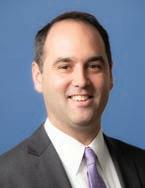


said his organization’s “wide-ranging membership is proud to partner with the railroad industry on an annual total of about four million carloads of grain and oilseeds and related produc tion inputs and products. It is a part nership critical to the U.S. agricultural economy and one we value.” Short line railroads share the pride in that part nership, and because rural America depends on us, we have an obligation to work diligently to make our part of the railroad network as efficient as possi ble. That is what we intend to do, and will do, in close cooperation with our agricultural customers.
An ASLRRA regional meeting will be held Oct. 25-27 in Milwaukee, Wis. Such always well-attended meetings provide an opportunity to engage a broad cross section of short lines on the best way to improve rural rail service. Short line senior executives will discuss their approach to supporting rural rail service and the many customers and towns that depend upon our service. In addition to these discussions, formal meeting sessions will feature Federal Railroad Administration staff covering a wide range of regulatory subjects; a Railroad Retirement Board member; senior Class I executives from CSX, Norfolk South ern and Union Pacific; and shippers including Home Depot, Georgia Pacific and Packaging Corporation of America. Short lines will once again be the critical connection point for shippers and Class I’s; we look forward to robust dialogue and the creation of shared solutions that will move the industry forward. I hope to see you all there.
44 Railway Age // October 2022
Mechanical Department Regulations
Now Includes Part 224
210 Railroad Noise Emission Compliance Regulations Updated 4-15-19. 215 Freight Car Safety Standards Updated 3-21-22 216 Emergency Order Procedures: Railroad Track, Locomotive and Equipment Updated 3-21-22 217 Railroad Operating Rules Updated 3-21-22 218 Railroad Operating Practices - Blue Flag Rule Updated 3-21-22 221 Rear End Marking Device-passenger, commuter/freight trains Updated 3-21-22
223 Safety Glazing Standards Updated 3-21-22
224 Reflectorization of Rail Freight Rolling Stock Updated 3-21-22
225 Railroad Accidents/Incidents Updated 3-21-22
229 Locomotive Safety Standards Updated 3-21-22
231 Safety Appliance Standards Updated 3-21-22
232 Brake System Safety Standards Updated 12-11-20.

BKMFR Mech. Dept. Regs. $34.50
Order 25 or more and pay only $31.00 each
FRA News:
There are no new proposals or final rules to report for this issue. Be sure to check back next month to see if there are any changes to FRA regulations.
Part 215: Freight Car Safety Standards
49 CFR 215. Prescribes the minimum safety standards for freight cars allowed by the FRA. Includes safety stan dards for freight car components, car bodies, draft sys tem, restricted equipment and stenciling. Softcover, spiral. Updated 3-21-22
BKFSS
Freight Car Safety Standards $9.50
Order 50 or more and pay only $8.50 each
Part 232: Brake System Safety Standards
50 or Each more
BKSEP 209 3-21-22 RR Safety Enforcement Procedures & 32.00 28.80 211 3-1-21 Rules of Practice
BKTSSAF 213 3-21-22 Track Safety Standards (Subpart A-F) 11.95 10.75
BKTSSG 213 3-21-22 Track Safety Standards (Subpart G) 12.50 11.25
BKWRK 214 3-21-22 RR Workplace Safety 11.50 10.35
BKFSS 215 3-21-22 RR Freight Car Safety Standards 9.50 8.50
BKROR 217 3-21-22 RR Operating Rules and Practices 11.50 10.35 218 3-21-22

BKRRC 220 3-21-22 RR Communications 7.75 6.95
BKHORN 222 3-21-22 Use of Locomotive Horns 15.75 14.15
BKHS 228 3-21-22 Hours of Service 13.50 12.15
BKLSS 229 3-21-22 Locomotive Safety Standards 13.50 12.15
BKSLI 230 3-21-22 Steam Locomotive Inspection 27.95 25.15
BKSAS 231 3-21-22 RR Safety Appliance Standards 11.50 10.35
BKSBSS 232 12-11-20 Brake System Safety Standards 17.50 15.75
BKBRIDGE 237 3-21-22 Bridge Safety Standards 8.95 8.00
BKLER 240 3-21-22 Qualification and Certification 14.95 13.45 of Locomotive Engineers
BKCONDC 242 3-21-22 Conductor Certification 13.50 12.15
49 CFR 232. Regulations and general requirements for all train brake systems, inspection and testing, periodic mainte nance and training requirements, and end-of-train devices for Class I, II, and III railroads. Plus the introduction of new brake system technology. Softcover. 155 pages. Updated 12-11-20
BKBSS Brake System Safety Standards $17.50

Order 25 or more and pay only $15.75 each
Part 231: Railroad Safety Appliance Standards
49 CFR 231. General requirements for safety appliances including: handbrakes, brake step, running boards, sill steps, ladders, end ladder clearance, roof handholds, side handholds, horizontal end handholds, vertical end hand holds, and uncoupling levers. 106 pages. Softcover. Updated 3-21-22
BKSAS
Railroad Safety Appliance $11.50
Order 50 or more and pay only $10.35 each
Part 229: Locomotive Safety Standards
The Locomotive Safety Standards cover the laws govern ing inspections and tests, brake system, draft system, suspension, electrical, cabs and cab equipment plus more! Softcover. Spiral bound. Updated 3-21-22
Each
BKCAD 40 4-23-19 Drug and Alcohol Regulations in 39.95 35.95 219 3-21-22 the Workplace
BKSTC 233 3-21-22 Signal and Train Control Systems 22.95 20.65 234 3-21-22 235 3-21-22 236 3-21-22
BKPSS 238 3-21-22 Passenger Safety Standards 26.95 24.25 239 3-21-22

BKINFRA18 Track and Rail and Infrastructure Integrity 39.95 35.95 Compliance Manual - Volume II, Track Safety Standards - Part 213



BKTM Technical Manual for Signal and Train 51.95 46.76 Control Rules. - Includes Part 233, 234, 235, 236
BKLSS
Locomotive Safety Standards $13.50
Order 50 or more and pay only $12.15 each
Item Code FRA Part #
*Prices subject to change. Revision dates subject to change in accordance with laws published by the FRA. 10/22 800-228-9670 www.transalert.com Add Shipping & Handling if your merchandise subtotal is: UP TO $10.00 $5.25 $10.15 10.01 - 25.00 9.70 16.90 25.01 - 50.00 13.20 22.06 50.01 - 75.00 14.85 27.55 Orders over $75, call for shipping U.S.A. CAN U.S.A. CAN The Railway Educational Bureau 1809 Capitol Ave., Omaha
I (800) 228-9670 I (402) 346-4300 www.RailwayEducationalBureau.com We’re current, are you? FRA Regulations Current FRA
Updates from the Federal Register may be supplied in supplement form. Update effective Combined FRA Regulations 25 or more Update effective Compliance Manuals FRA Part #
NE, 68102
Regulations
A
reprint of the
Regulations that apply specifically to the Mechanical
Spiral bound.
combined
Federal
Department.
Part Title
FLAWLESS BOLTING
The newly designed B-RAD Select Series offers higher speed and longer battery life while incorporating a new torque display with buttons. The B-RAD Select allows the user to easily select the target torque.































• Digital torque settings
• Torque ranges up to 7000 Nm
• Equipped with the latest lithium-ion technology
• Suitable for pre-torque and service jobs where electricity or compressed air are not available
• Longer battery life as energy is used more efficiently
SELECT BOOK A DEMO 1.800.983.0044 | WWW.RADTORQUE.COM
B-RAD



































































































































































































































 BY WILLIAM C. VANTUO N O, EDITOR-I N -CHI EF
BY WILLIAM C. VANTUO N O, EDITOR-I N -CHI EF
 BY DAVID C. LESTER, MANAGING EDITOR, RT&S
BY DAVID C. LESTER, MANAGING EDITOR, RT&S










 P.E., Vice President, Fry Technical Services, Inc.
P.E., Vice President, Fry Technical Services, Inc.




















































